

inks inks
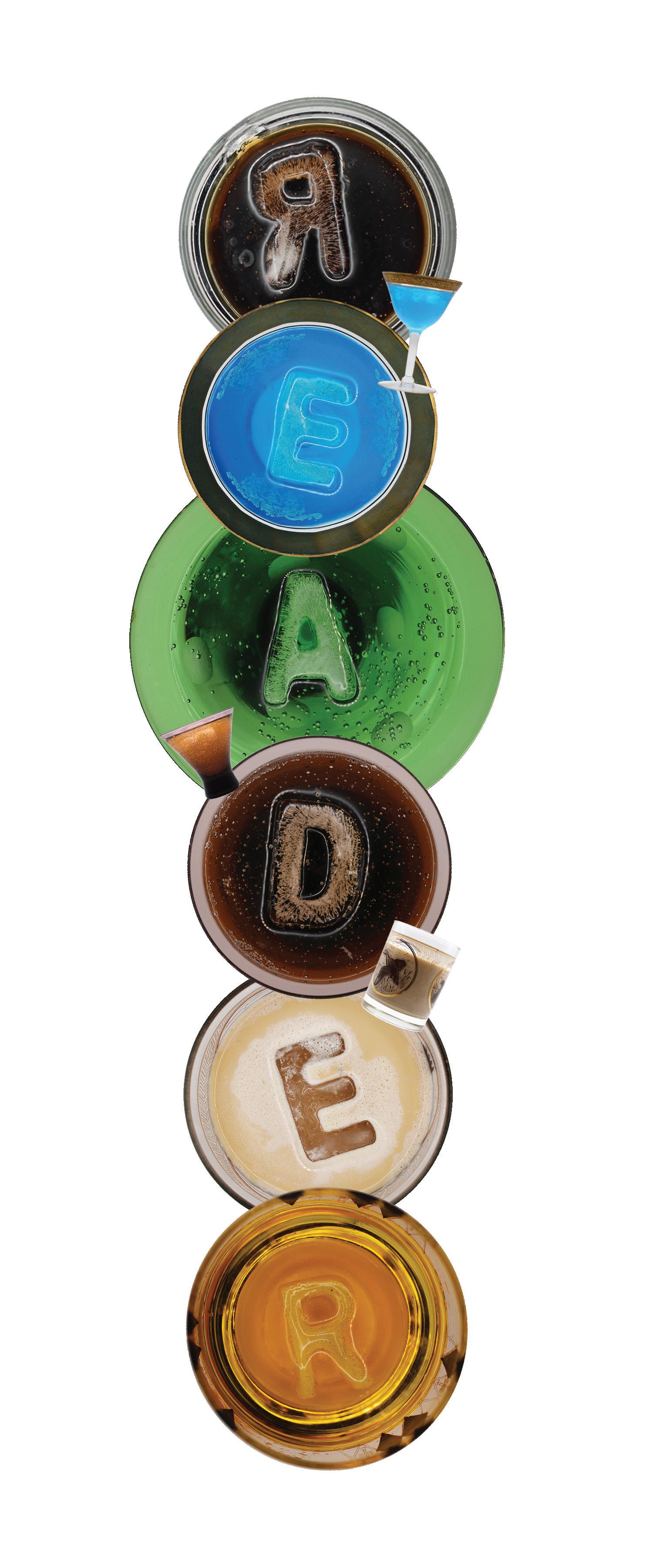
THIS WEEK
DRINKS
04 Staff Note | Williamson Ice, not ICE 06 Roundup | Caporale & Sula Winter is coming. Here are five new bottles that will rekindle your blackened heart.
08 Feature | Caporale A tale of two wormwoods 12 History How immigrants shaped Chicago’s bar scene
16 Theater | Reid Drinking shows let you belly up to the theater.
CITY LIFE
05 History Chicagoans have long resisted legalized kidnappings of our neighbors
NEWS & POLITICS
10 Feature | Brown Tenants call for an eviction moratorium amid ramped-up deportations.
11 Make it Make Sense | Hugueley & Mulcahy Trump’s invasion continues, layoffs and labor issues cause strife at Uptown People’s Law Center, and city domestic violence services face budget cuts in 2026.
ARTS & CULTURE
14 Cra Work Yuliya Klochan uses Ukrainian loom weaving techniques in her colorful beaded artworks.
15 Art of Note Recommended solo shows at the Arts Club of Chicago and on the Art Institute terrace
THEATER
18 Plays of Note An enchanting musical version of As You Like It at Writers Theatre, a revival of Richard Foreman’s Bad Behavior, and a darkly comic adaptation of A Devil Comes to Town at Trap Door Theatre
FILM
20 Moviegoer Eye works
20 Movies of Note Predator: Badlands is unlike any other Predator movie, and Sentimental Value is tender and heart-wrenching.
MUSIC & NIGHTLIFE
22 Secret History of Chicago Music Charles E. Gerber sparked kids’ imaginations as the elfin host of The Magic Door
24 Shows of Note Previews of concerts including Pixel Grip, Rwake, and Danny Brown
26 Gossip Wolf Torn Light Records reopens a er a month of mopping up, the Fallen Log shuts its doors, and more. CLASSIFIEDS
27 Jobs
27 Services
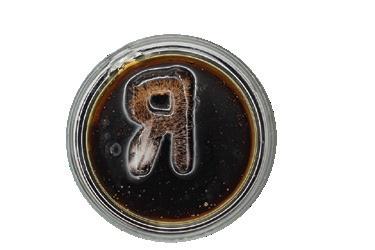

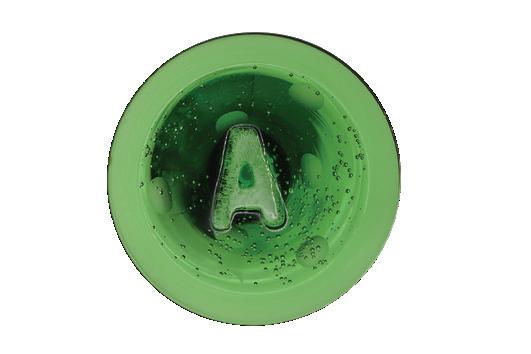
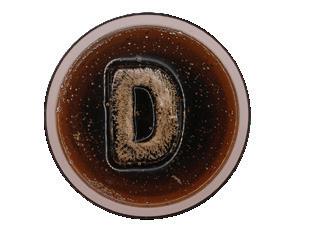

Drinks






INTERIM PUBLISHER ROB CROCKER CHIEF OF STAFF ELLEN KAULIG
ASSISTANT MANAGING EDITOR
SAVANNAH RAY HUGUELEY
PRODUCTION MANAGER AND STAFF
PHOTOGRAPHER KIRK WILLIAMSON
SENIOR GRAPHIC DESIGNER AMBER HUFF
GRAPHIC DESIGNER AND PHOTO RESEARCHER SHIRA
FRIEDMAN-PARKS
THEATER AND DANCE EDITOR KERRY REID
MUSIC EDITOR PHILIP MONTORO
CULTURE EDITOR: FILM, MEDIA, FOOD AND DRINK TARYN MCFADDEN
CULTURE EDITOR: ART, ARCHITECTURE, BOOKS KERRY CARDOZA
NEWS EDITOR SHAWN MULCAHY
PROJECTS EDITOR JAMIE LUDWIG
DIGITAL EDITOR TYRA NICOLE TRICHE
SENIOR WRITERS LEOR GALIL, MIKE SULA
FEATURES WRITER KATIE PROUT
SOCIAL JUSTICE REPORTER DEVYN-MARSHALL BROWN (DMB)
STAFF WRITER MICCO CAPORALE
SOCIAL MEDIA ENGAGEMENT
ASSOCIATE CHARLI RENKEN
VICE PRESIDENT OF PEOPLE AND CULTURE ALIA GRAHAM
DEVELOPMENT MANAGER JOEY MANDEVILLE
DATA ASSOCIATE TATIANA PEREZ
MARKETING MANAGER MAJA STACHNIK
MARKETING ASSOCIATE MICHAEL THOMPSON
SALES REPRESENTATIVE WILL ROGERS
SALES REPRESENTATIVE KELLY BRAUN
SALES REPRESENTATIVE VANESSA FLEMING
ADVERTISING
ADS@CHICAGOREADER.COM, 312-392-2970
CREATE A CLASSIFIED AD LISTING AT CLASSIFIEDS.CHICAGOREADER.COM
DISTRIBUTION CONCERNS
DISTRIBUTIONISSUES@CHICAGOREADER.COM
READER INSTITUTE FOR COMMUNITY
JOURNALISM, INC.
CHAIRPERSON EILEEN RHODES
TREASURER TIMO MARTINEZ
SECRETARY TORRENCE GARDNER
DIRECTORS MONIQUE BRINKMAN-HILL, JULIETTE BUFORD, DANIEL DEVER, MATT DOUBLEDAY, JAKE MIKVA, ROBERT REITER, MARILYNN RUBIO, CHRISTINA CRAWFORD STEED




STAFF NOTE
Can art only exist as an expression of beauty, or must it make a statement?
This was a question I had to ponder throughout the process of creating the cover for this issue, which features content related to drinking. What could have felt like a carefree caprice of a concept in a di erent time has now taken on an unexpected semantic workload. You can’t just take pretty pictures of ice and not think about ICE (Immigration

and Customs Enforcement). And this pisses me right the fuck o , both as an artist and as a U.S. citizen with a beleaguered conscience. As I came up with the concept for this cover, I went into the process with a zesty curiosity. I wanted to make ice that was as clear as possible and would photograph well. To do this, I used the “kitchen sink” approach, employing multiple methods to achieve the cleanest product. I used distilled water, which I then filtered and boiled. But for the most part, those tricks don’t matter too much. The key is a method called directional freezing, in which the sides and back of the ice tray are insulated, forcing all freezing action to come from the top, pushing all impurities down rather than concentrating them in the inaccessible center.
Satisfactorily as the end result may have turned out, it feels irresponsible to present this visual celebration of frozen water without addressing the elephant in the White House. Can’t a brother just make pretty pictures without it relating to the hellscape that is 2025 America? God, that would be nice. It’s my main wish—both for me personally and for my brothers and sisters in the fight for justice and a peaceful society—that we could do just that. But not now. Not today. I give it up to the Reader editors, whose job it is to steer this ship through the choppy waters of our turbulent political situation, always remaining upright and not taking on any water. OK, before I’m put on trial at the Hague for torturing this pitiable metaphor (which is more justice than the ICE jackboots
will ever see), I just want to say that it takes courage to continue to stand for what’s right, and I believe that we at the Reader and other local outlets have not wavered from that task. Our journalists have kept front and center in the fi ght and have provided coverage in a way that respects the victims of the current regime and have held the feet of the perpetrators to the fi re. Fire melts ice, after all.
So, this week, have a drink, stay cool, continue to kick ass, and tip your servers. v —Kirk Williamson, production manager/ sta photographer m kwilliamson@chicagoreader.com
CORRECTIONS
The Reader has updated the online review of Uz, el pueblo entitled “Town without pity, ” written by Kerry Reid and originally published in our November 6 issue (volume 54, number 6). The piece now correctly states that the son in the play is Tomás, not Jose, and played by Israel Balza, not Oswaldo Calderón.
The Reader has updated the online version of “Many unhoused Chicagoans uncounted among the disappeared,” written by Katie Prout and originally published in our November 6 issue (volume 54, number 6), to clarify that two abductions, on September 23 and October 24, occurred outside the same North Park shelter, and that the October 29 incident witnessed by Kiersten Solis occurred near Gompers Park, not Eugene Field Park.
The Reader updated some phrasing in the online review of the movie Violent Ends written by Kyle Logan and originally published in our November 6 issue (volume 54, number 6), to clarify the writer’s intent.
Find us on socials: facebook.com/chicagoreader twitter.com/Chicago_Reader instagram.com/chicago_reader linkedin.com search chicago-reader
The Chicago Reader accepts comments and letters to the editor of less than 400 words for publication consideration.
m letters@chicagoreader.com

Southeast Spotlight:
Medley Grill & BBQ

Bringing the best BBQ to the Southeast Side & beyond
Any good recipe is rooted in family origins, but it often involves some variation and experimentation as it is passed through generations. Similarly, as folks move and travel and try new things, flavors and notes of those experiences follow them. This is exactly how Charles Thurman, founder and master barbecuer of Medley Grill & BBQ, conjured up his array of delicious dishes.
The name “Medley” reflects his process: a mixing of smoke, fire, and seasonings to cook food. What started as a passion in 2014 was slow-roasted into a brickand-mortar space in 2022. “It’s BBQ from the heart,” Thurman modestly shared. Every meal is made from scratch, ensuring quality and stellar taste every day. After years of building up the Medley Grill & BBQ brand, Thurman is confident in letting the smoky, soulful foods speak for themselves. Uniquely, Medley does not provide pork on their menu— making it stand out from most traditional BBQ restaurants—

but still offers a variety of delicious options for everyone, from turkey tips to all the sides one could need.
Like all good restaurants that keep us coming back, Medley Grill & BBQ prioritizes care and consistency. Thurman understands personally that people work hard for their money, so he wants to ensure that they are satisfied and full when they choose Medley for nourishment. Additionally, as a Black business owner on the southeast side, Thurman is fueled by the opportunity to serve his community with good food and good business practices.
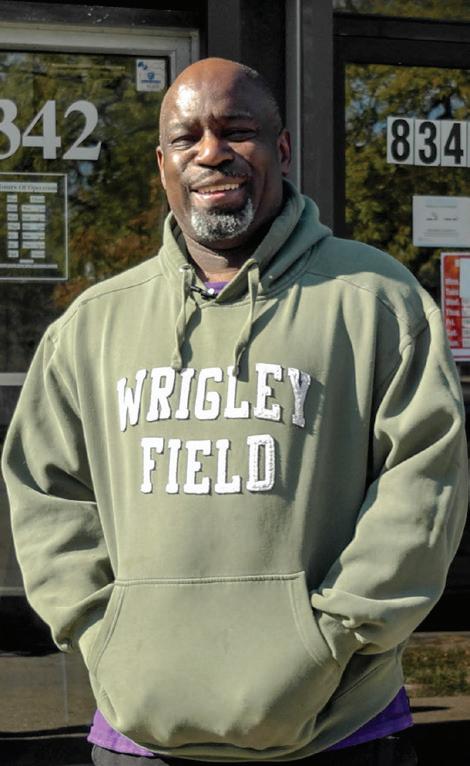
When the weather is fine, especially during Chicago summertimes, Medley’s semisecret patio is a sanctuary to enjoy a meal alone or shared with some friends. Grab takeout or cater your next party with Medley Grill & BBQ. Be sure to follow along on social media to stay tuned for their next fish fry or Sunday backyard BBQ for the Bears’ game!
Medley Grill & BBQ
8340 S. Stony Island, Chicago, IL 60617
Wednesday 10:30 AM-7 PM; Thursday-Saturday 10:30 AM-8 PM; Sunday 11 AM-8 PM | medleygrillandbbq.com | @medley_grill_and_bbq 312-922-1272 or medleygrillbbq@gmail.com

KIRK WILLIAMSON
This content is sponsored by the Southeast Chicago Chamber of Commerce
Courtesy Medley Grill & BBQ
CITY LIFE
Chicago has always defied kidnappings of our neighbors
Even a er the passage of the 1850 Fugitive Slave Act, local officials and everyday people resisted the legalized abductions of Black Chicagoans.
By JEFF NICHOLS
Chicagoans have a long history of making it hard for outsiders to abduct people o our streets. In the 1850s, lawyers, judges, and politicians jammed up the legalized kidnapping of men, women, and children who had escaped slavery. Ordinary Chicagoans refused to be silent when armed “slave catchers,” which included enslavers and bounty hunters, attempted to snatch Black people from public spaces.
Take the case of Uriah Hinch, a slave catcher from Audrain County, Missouri. Hinch didn’t know what the escapees looked like, so one of the enslavers who had hired Hinch “lent” out Henry Stevenson, a man who was enslaved at the time. Through Stevenson’s detective work among free Black people, the pair arrived in Chicago in October 1850.
Convinced that Stevenson was making inquiries among Black folks, Hinch tried to distribute fliers describing the people he was trying to kidnap, when, in the words of the antislavery paper Western Citizen , a few gentlemen “kindly informed” Hinch that he was “employed in an enterprise of personal hazard.” Meanwhile, Stevenson was on a boat to Michigan; he had connected with members of the Underground Railroad at a barbershop.
ers. Passed a few weeks earlier, the Fugitive Slave Act imposed heavy fines against anyone who impeded arrests. The a davit of a slaveholder was enough to put an accused Black person into permanent servitude. One correspondent to the Western Citizen reported that a Black man, who had escaped slavery just four years earlier, tearfully explained to a church congregation how the new law “had driven all protection from him, and he had no home, no
Moses Johnson into bondage on the grounds that Johnson’s appearance didn’t match an enslaver’s written description. Though penniless, Johnson had been defended pro bono. A boisterous crowd outside the courthouse jeered at the slave catcher.
Events in September 1854 only solidified the image in the pro-slavery press that Chicago was hopelessly lawless and corrupt. After antislavery activists heckled a speech by Senator Stephen A. Douglas, in which he defended compromises to pacify enslavers, papers across the south reprinted the description o ered by the Douglas-owned Chicago Times, which characterized the event as an attack on free speech by a radical mob.
Southern papers were appalled at how three Missouri slave catchers had been charged in Chicago for assault with a deadly weapon. They had hauled a formerly enslaved man across the sidewalk, firing a pistol at him as he attempted to flee. An indignant statement prepared by the defendants complained that some in “the mob came up to us and told us to leave, saying that we, or anybody else, could not take a negro from Chicago.”
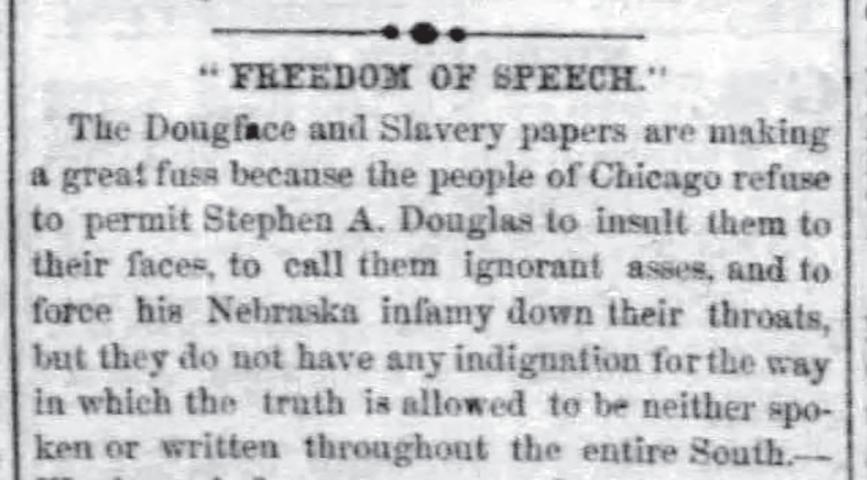
Indifferent to the safety of Chicagoans, a Boonville, Missouri, paper fumed at how the man had been “assisted to make his escape,” while the “persons duly authorized to take him” had been thrown into jail.
and Bagsby were staying, Isbell gathered 14 other Black men who ambushed their cabin at Polk and State. Decades later, Isbell reckoned Calvert and Bagsby would have needed “a couple of weeks” to recover from their beatings. Federal pressure against Chicago increased as the Civil War approached. In November 1860, the kidnapping of a formerly enslaved woman named Eliza Grayson nearly triggered an uprising. Chancellor L. Jenks, an antislavery lawyer, clocked the enslaver who had stalked Grayson for the previous two years. Jenks connived to have the would-be kidnappers, who had procured a warrant against Grayson, arrested for disorderly conduct. Though Grayson managed to escape, Jenks and eight others were arrested for violating the Fugitive Slave Act.
Fearing for his safety, Hinch sought the protection of a Chicago judge, who simply referred him to an antislavery lawyer. Following the advice of his legal counsel, Hinch left town. The next day, the escapees arrived in Chicago. Had Hinch crossed paths with the escapees, he could have tried to get a warrant for their arrests, thus making U.S. marshals do the dirty work of subduing and securing freedom seek-
spot on earth he could call his own.” After the passage of the Fugitive Slave Act, one mass meeting of Black Chicagoans resolved that “we will stand by our liberty at the expense of our lives.” Though there were white Chicagoans who vigorously defended the law, a clear majority of Chicagoans resented the political and economic power of slaveholders. After some flip-flopping, Chicago aldermen passed a resolution condemning the Act on the grounds it infringed on basic civil rights; the city would not volunteer its police force to help enslavers. The Act had been crafted to force communities like Chicago from being a sanctuary for freedom seekers. In June 1851, U.S. commissioner George W. Meeker refused to send
The threat of violence between the hired goons capturing freedom seekers and the communities that protected them hung over the city. In December 1854, Saint Louis slave catchers obtained warrants for 17 escapees, the news of which spread quickly. Receiving no help from the mayor to deal with potential conflict with gathering crowds, the U.S. marshal from Springfield called in the National Guard. In the commotion, no one was captured. Lamenting the future economic damage to Missouri, a furious correspondent to the St. Louis Republic wrote, “I would not recommend any citizen of a southern State to attempt to get his property here with being well backed by a strong force.”
A few months later, a U.S. marshal tipped o Lewis Isbell, a Black barber, that two slave catchers from Missouri, Joe Bagsby and James Calvert, had asked them to arrest two freedom seekers. Isbell sought out the two Missourians, who o ered Isbell a handsome reward for his help. Now, having found out where Calvert
On April 3, 1861, J.R. Jones, a U.S. marshal appointed by President Abraham Lincoln, executed the early morning arrest of the Harris family. Angry neighbors followed the family of five to the train station, but they were unable to be rescued and were eventually returned to bondage in Missouri. This incident triggered a panicked exodus of Black Chicagoans. Bashed by the pro-Lincoln press and under a new set of priorities with the start of the Civil War, Jones stopped hunting freedom seekers. The charges against Jenks and his compatriots were also dropped. There is much to admire in the town that stood up against the Fugitive Slave Act, but it was no racial utopia. It was one thing for white Chicagoans to hoot at slave catchers—yet another for them to consider Black Chicagoans their betters, let alone their equals. When the Underground Railroad was but a memory, white Chicagoans could imagine themselves as its indispensable leaders, relegating the stories of those like the barber, Lewis Isbell, to the margins. In reality, as Larry A. McClellan writes in Onward to Chicago: Freedom Seekers and the Underground Railroad in Northeastern Illinois, Isbell was “at the center of activity for assisting freedom seekers.” Isbell was recognized as a leader among his Black and white peers, who might have helped, directly and indirectly, up to a thousand people find freedom in Canada.
Today, Isbell lies in an unmarked grave in Mount Olivet Catholic Cemetery. Stephen A. Douglas, whose business portfolio included a 2,500-acre cotton plantation in Mississippi, lies in a grand monument overlooking the lake. v
m letters@chicagoreader.com
Chicago Tribune article from September 12, 1854 CHICAGO TRIBUNE


Drinks
ROUNDUP
New local spirits to li your spirits
Winter is coming. Here are five new bottles that will rekindle your blackened heart.
By MICCO CAPORALE & MIKE SULA
Last summer, I was dithering with a friend in the tequila aisle at the liquor store and grousing about mezcal and other agave spirits’ superiority to tequila, the less compelling and deceptively manufactured social lubricant and regrettable emetic of frat houses everywhere. A stranger rolling his cart overheard, stopped, and insisted on buying us a bottle of his own tequila brand. We took it to a party, and when I tasted just how complex and interesting it was, I hid it away before it was completely drained. I only learned later that our mysterious booze benefactor was none other than Chef John des Rosiers—best known for Lake Blu ’s fine-dining restaurant Inovasi—who’d just launched his own brand a year earlier, informed by his decades as an ad hoc sommelier in every restaurant he’s ever worked. With the holidays approaching, Chicago is awash in similarly interesting, newly released local spirits. Here are a few we found that were our great pleasure to sip—so you have to.
Apologue carrot liqueur
If carrot cake came in a liquid form, it’d be Apologue’s carrot liqueur. The distiller uses carrots from Marengo, Illinois–based Nichols Farm & Orchard and combines them with ginger, cinnamon, lemon, mint, citrus, and cinchona for a tooth-achingly sweet concoction that, when served alone, is best enjoyed in small sips after dinner. Like most liqueurs, it’s much better as a mixer, providing a versatile, earthy-sweet base that can ground fall flavors like orange and ginger with a hint of surprise. Of course, it goes with tonic; including cinchona in the recipe leaves the door wide open for more quinine flavor. Whiskey is an obvious partner spirit (bourbon
would be too sweet, in my opinion), but I tasted the most room for possibility in a smoky mezcal. Apologue’s carrot liqueur makes a great mixer for drinks trying to scream “fall”—but in the right bartender’s hands, it could be part of a drink so interesting it transcends the season. —MICCO CAPORALE $40, preorder for $35 at apologueliqueurs.com
Cambio tequila reposado
After marrying into a Mexican extended family, John des Rosiers and one of his 92 new first cousins rebuilt a Jalisco distillery to complement his roster of North Shore restaurants. Along with the additive-free blanco it’s built upon, the

French oak barrels.

“Cambio” means “change,” and while they adhere to traditional methods—whole agave hearts cooked in brick ovens, stone tahonas to press the juice, wooden fermentation tanks, copper stills—they’re also breaking new ground. Des Rosiers takes a vintner’s approach, using imported yeast strains more common to winemaking that coax rarely expressed flavors from the agave, fermenting at low temperatures, and bottling at a lower proof (50 percent ABV). Everything about the process is low and slow, taking three times as long as the average mass-market tequila, according to des Rosiers. Out of the bottle, it has a
vanilla-kissed, smoky nose, and a gently floral, caramel drift across the palate. No shots with this one, —MIKE SULA $54.99 at liquor stores all over Chicagoland
Granor hopper rye
Best known for its greenhouse dinners led by former Chicago chef and cookbook author Abra Berens, southwest Michigan’s
Leatherbee pomme aperitif
To make its pomme aperitif, Leatherbee takes the fermented apple juice, or “apple wine,” of Virtue, a Michigan-based apple farm and cidery, and fortifies it with a neutral grain spirit and artichoke. Aperitif wines are meant to be consumed before meals, not after, so they tend to be drier and lighter. The pomme aperitif is sweeter and a bit more full-bodied than one might expect, but it’s not cloying or heavy. Rather, it has a subtly hearty quality with a faint herbiness that feels very appropriate for fall—especially when served

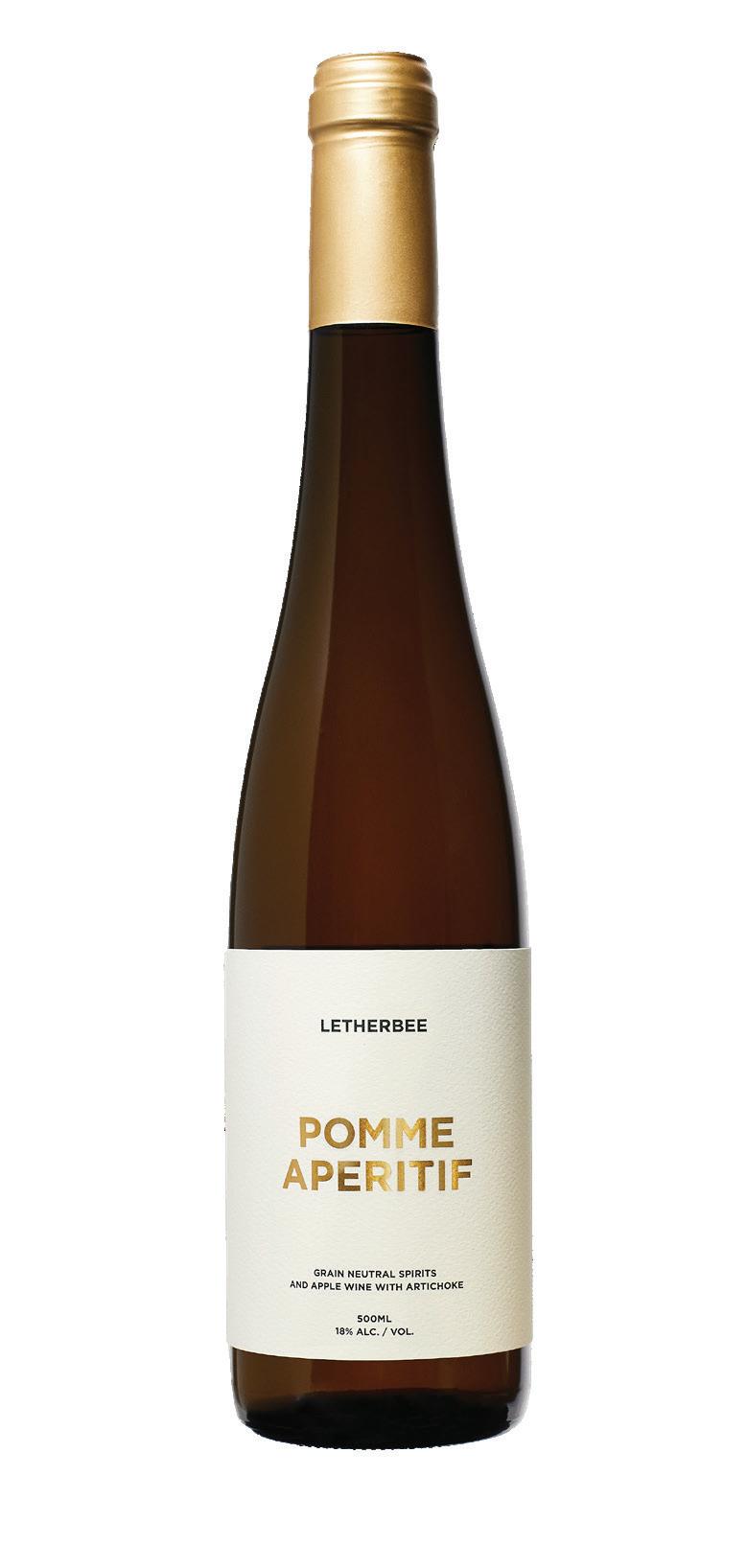
COURTESY CAMBIO
E.E. BERGER
COURTESY LEATHERBEE
Drinks


hardly refined.) I tried adding lemon to see if that would bring out its fl avor, but the lemon quickly flattened the wine’s overall depth. It mixes well with soda water or tonic for a spritz (bitters optional— though an orange one would be nice). I quite liked it with tonic (especially elderflower tonic) and Sweet Gwendoline gin, too. (Sweet Gwendoline is an atypical gin with a less floral, more spicy flavor.) Combined with the aperitif and tonic, it was like drinking a slice of very sophisticated apple pie. —MICCO CAPORALE
Agora Market, Olivia’s Market, Maison Pasquale, and 57th Street Wines
Wandawega whiskey
Elkhorn, Wisconsin’s meticulously restored erstwhile “house of ill repute,” Latvian church camp, and potential Wes Anderson film set introduced this cutesy ass pocket filled with four-to-six-year-old bourbon; it’s meant to


commemorate the glass pints that, as the story goes, Wandawega’s Madame Anna Peck hid from the Feds in her piano. It’s a blend of juice from Indiana’s mega-industrial MGP distillery, and Owensboro, Kentucky’s historic 140-yearold Green River Distilling Co. It’s aged partly in Owensboro and partly in Pilsen at CH Distillery, where it’s also blended and bottled. Yes, it’s a bit of a prop. You can pull it out of your knickers and knock it back like you’re one of those snacky Wandawega models. But with a high corn mash bill, it has a smooth, creamy texture and honeyed caramel notes, and I’d be just as chu ed to —MIKE SULA $10 at the camp store or Chicago Foxtrot Markets v
m mcaporale@chicagoreader.com
m msula@chicagoreader.com




















































COURTESY CAMP WANDAWEGA



Drinks
FEATURE
A tale of two w mwoods
Exploring the intersecting histories of absinthe and Malört—and why Chicagoans prefer the latter
By MICCO CAPORALE
Chicagoans are bitter. We’re other things, too: brave, resourceful, imaginative, animated—but we’re bitter as hell. Maybe it’s the winters. They’re not as bad as those in other midwestern cities, but ours have the added chill of the wind whipping o the lakefront. It makes us so uniquely bitter we act entitled to parking spots in perpetuity after heavy snow. (You cannot convince me dibs isn’t colonizer energy, but that’s a di erent article.)
Maybe we’re bitter because our city is treated as the lesser sister of Los Angeles or New York. Our rising stars relocate when they decide the city’s too small for their shine, and media misrepresentation of Chicago is so common Vulture even ran a story called “Why does Netflix hate Chicago?” We all know how ideas of Chicago in the national imagination get manipulated to justify political cruelty that impacts us daily. There are a million reasons why we’re bitter—but there’s something about that cultural identity of the wounded underdog that makes us delight in selfflagellating with one of the most bitter spirits of all: Jeppson’s Malört.
Jeppson’s is made from macerating wormwood in a grain neutral spirit. That’s where the liqueur gets its name: “Malört” is Swedish for “wormwood.” But there’s another famous liqueur made in a similar way that’s also a translation of wormwood: absinthe, which comes from the French word. It shares the same Latin root as the plant’s scientific name: Artemisia absinthium . But whereas Malört slowly— slowly —went from a niche spirit to a Chicago icon stocked at every bar in town, absinthe’s never had a huge footprint here. It makes sense that something homegrown would take on more cultural significance, but the virtual absence of Malört’s French cousin in Chicago reveals just as much about the city as the Swedish beverage’s ability to thrive.
Wormwood has a rich countercultural history. It’s been favored in esoteric traditions throughout the world for centuries, and it’s been a staple in folk medicine since before the Bible, too. References to wormwood have been found in ancient medicinal texts in places such
as present-day China, Greece, and Egypt. Both Malört—the trademarked name of one immigrant’s bësk recipe—and absinthe started as folk medicinal drinks for digestive issues. The former, which is a flexible family of wormwood-based spirits, originated in Sweden in the 1400s and the latter in Switzerland in the 1700s. (Interestingly, “bësk” can mean “bitter” or “caustic.”)
Unlike absinthe, bësk has never been banned, in the United States or elsewhere. Switzerland first banned absinthe in 1910, and by 1915, it was forbidden in most of western Europe and the United States. Prohibition began in 1920, but Swedish immigrant Carl Jeppsen, Malört’s founder, was able to skirt prohibition laws by selling bësk as a cure for stomach parasites. Absinthe did not become legal again in the United States until 2007. There are a lot of reasons why absinthe was singled out as more dangerous than other alcohol. Most of it comes down to white supremacy and anti-Semitism. Absinthe was commercialized in the early 1800s using a recipe that began with fermented or distilled grapes, but in the 1860s, a pest infestation and a lot of mildew ruined vineyards throughout France and other parts of Europe (historians call this the “French Wine Blight”). Winemakers were fucked, but absinthe makers could pivot to a beetroot-based spirit and continue.
Until the 1860s, absinthe hadn’t been especially popular in France. It was a drink mostly known among soldiers returning from Algeria, who were served it while colonizing northern Africa—supposedly to break fevers, prevent dysentery, and ward o insects. When they came back, they brought their appetite for “une verte” with them, which some civilians adopted as a shared symbol of empire. At first, absinthe was largely a middle- and upper-class indulgence, but absinthe is very high proof (45 to 75 percent ABV to wine’s 5 to 20 percent). People—especially poets and artists, who were quick to memorialize the unusual green drink in their work—soon realized their francs bought a lot more buzz with absinthe than wine. When the wine supply fell apart, absinthe had a captive audience.
About the same time, in 1867, a man named Valentin Magnan was appointed physicianin-chief at France’s primary mental asylum. E ectively, he became the state’s o cial authority on mental illness. France was a culture in decline, he thought, one corrupted by decadence and disorder. Like many nationalists, he believed in a “French race,” and it was being “degenerated.” Despite many studies to the contrary, he repeatedly blamed absinthe as a culprit. For years, he published a lot of pseudoscience on “absinthism,” a form of alcoholism he believed was separate and more sinister. Hardly anyone in the scientific community agreed with him—but winemakers did.










of deficiency. (Unsurprisingly, today’s French wine lobby loves funneling itself through the far right.)
Winemakers were thrilled with Magnan’s “research” touting absinthe as the drink of degenerates. They used it in anti-absinthe marketing campaigns that emphasized how healthy and patriotic wine is. (Magnan frequently discharged alcoholics from his asylum with a prescription to “only drink wine.”) The wine lobby’s campaigns also exploited a growing wave of anti-Semitism—so much so, some absinthe makers began to advertise they were not Jewish.
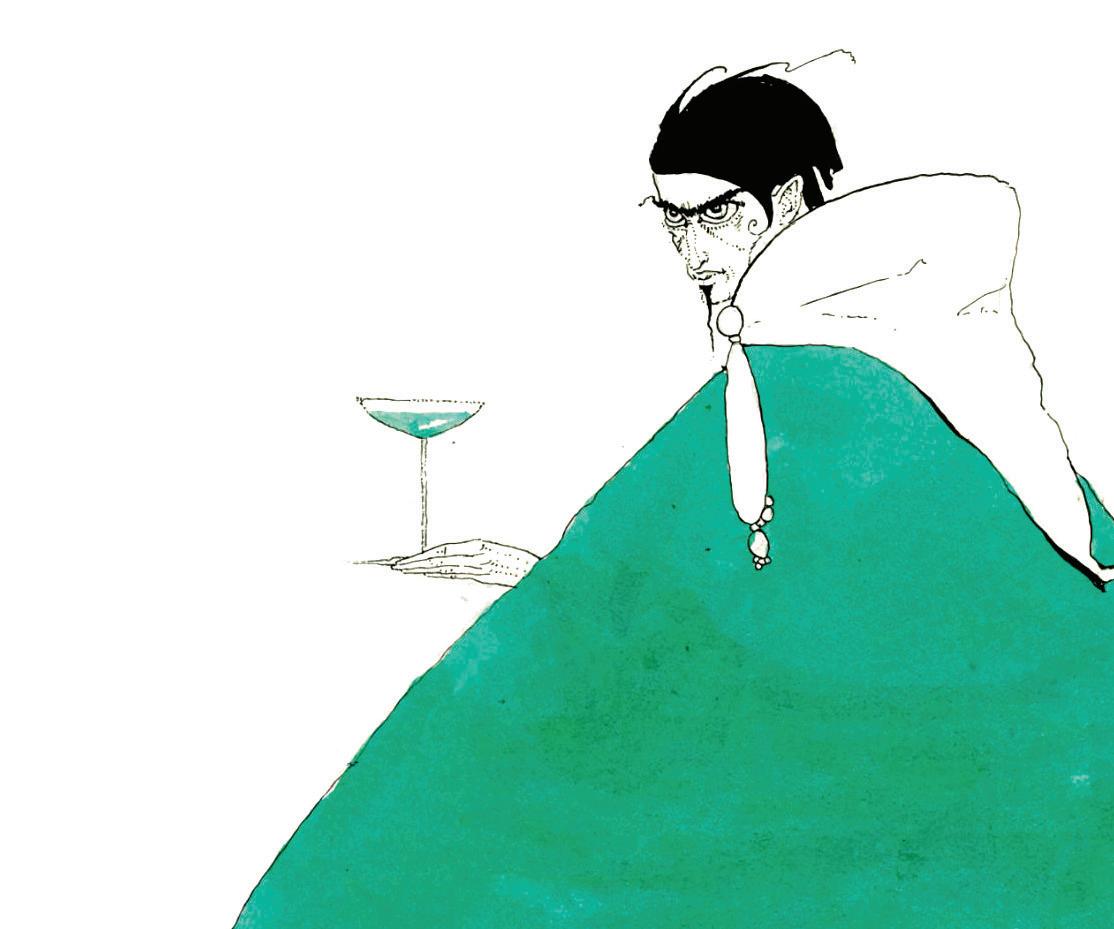







absinthe in France was owned by a French Revolution. Prior,

Near the end of the century, winemakers were bouncing back from the wine blight and wanted to regain their market share. At its peak, absinthe never accounted for more than 3 percent of all alcohol consumed in France, but the mere impression of its popularity o ended winemakers. The oldest and most popular absinthe in France was Pernod, which was owned by a nouveau-riche Jewish family who had little political influence. Most winemakers had bought their vineyards at auction during the French Revolution. Prior, the vineyards had primarily belonged to the church. Postrevolution winemakers still wanted to command high prices for France’s best wines, so they needed a performatively democratic marketing strategy: Expensive wine isn’t for wealthy people—it’s for healthy people . . . who are patriots! Wealth just happens to be an inevitable reward for good health and patriotism, and lack of wealth is a symptom
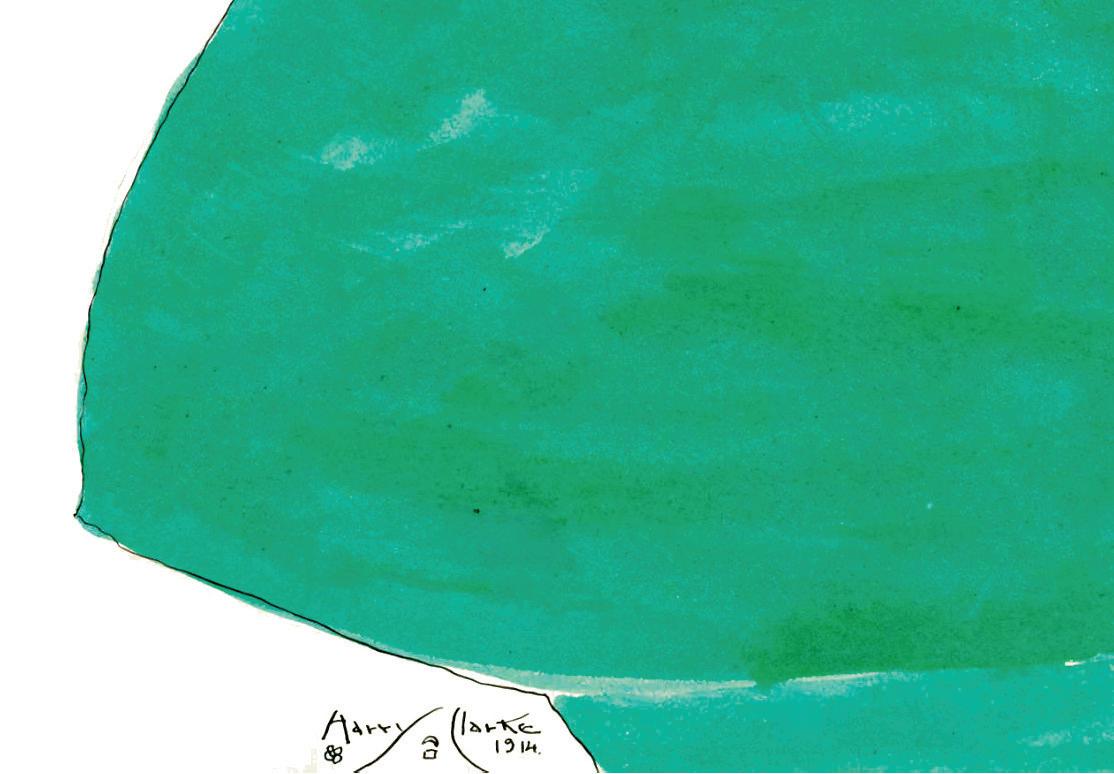
Concern about absinthe wasn’t entirely unwarranted. People who drank an awful lot of it on a regular basis did seem to act, well, chaotically and dangerously—much more so than your average drunk. Magnan blamed this on thujone, a chemical found in wormwood that, in high doses, can produce psychedelic peak, absinthe never accounted
Mephisto, 1914
effects and psychotic behavior. Contemporary scientists have a different perspective, not only from analyzing the thujone levels in pre-ban absinthes (they’re about the same as today’s legal limit), but also looking at the era’s sociopolitical factors.
Alcohol production was not regulated at the time, so it’s likely that the cheapest absinthes contained

Who was most likely to consume cheap absinthe? Poor people. Of course they were the ones most often seen behaving erratically on absinthe. If absinthe was causing moral, cultural, and health decay, it was because too many distillers were making unsafe choices to turn a profit—not because absinthe was popularized by a Jewish family or consumed by the working class.
All of this is clear in hindsight, but it was less obvious at the time. In 1905, antiabsinthe hysteria reached its zenith with a case press deemed the “absinthe murders.” Over the course of a day, a French laborer in Switzerland got very drunk on two ounces of absinthe, as well as wine and at least three
other liquors, then murdered his pregnant wife and children and attempted suicide. He survived and was arrested, but his second try, in his jail cell, three days after his trial, was successful. It was a salacious tragedy perfect for international notoriety, which the growing temperance movement used to their advantage. In 1910 Switzerland became the first European country to ban absinthe. Several other western countries followed suit, and bans remained in e ect well into the 2000s.
Malört started coming into vogue in Chicago about the same time absinthe was re-legalized. Single bottles sat on dive bar shelves collecting dust like forgotten cultural memories. It had some cache in Swedish, Polish, and Mexican communities, but mostly no one cared. Then Sam Mechling, a former bouncer at a wine bar where a coworker first dared him to try it, started giving shots to unsuspecting people. He loved witnessing their reactions—so much so, he started Facebook and Twitter accounts documenting their faces with added commentary like, “It tastes like the day dad left.” By 2012, he was hosting Malört events and selling Malört T-shirts at the now-defunct bar Paddy Long’s. His e orts became so renowned that they caught the attention of the company’s then owner, Pat Gabelick, who showed up to the bar with a lawyer prepared to confront him. Instead, she o ered him a job. That same year, small local startup distillery Letherbee debuted its absinthe. Letherbee started in 2011 after founder Brent Engel’s homemade moonshine grew a cult following from being sold at shows. He started with gin but quickly set his sights on absinthe.
“The process of making it is essentially the same,” he explains. “It’s just a di erent set of herbs, a di erent recipe.”
Engel had been working at Lula Cafe since 2009 and was inspired by a pastry chef making fennel-and-anise shortbread cookies. In addition to wormwood, true absinthe must contain fennel and anise, so the cookies got Engel thinking about using vanilla to temper wormwood’s bitterness. “I really saw an opportunity to make an absinthe aged in American oak,” he says. “The vanilla flavors from the oak work
beautifully.” It gives an American twist to the historically Swiss distillation process—and in 2012, it wasn’t hard to convince people to try it.
“During those years the repopularization of the Prohibition-era cocktail bar [put] a lot of more esoteric spirits back on the radar,” he says. “People were more adventurous. Good food was really sweeping the nation. The farm-to-table concept was taking o . Chicago was in the middle of all these trends that made people more passionate about food and drink. People would go out for dinner and drink three or four cocktails. Now people might have one before dinner. I think people drinking less is probably good. But the drinking culture is nowhere close to where it was ten years ago.”
Drinking absinthe isn’t exactly a casual experience today. Because of its high proof, it’s recommended to drink absinthe in a ratio of roughly one part alcohol to three-to-five parts water (the colder, the better). When water mixes with the liqueur, it opens up the drink’s flavors while releasing the oils in the anise, causing a clouding e ect known as the “louche”—a word that is also French slang for a person of questionable character. People took to placing a sugar cube atop a flat spoon before adding water so it would balance absinthe’s bitterness.
Cafe culture thrived in the Belle Époque, and absinthe was ubiquitous enough for even the most lowbrow establishments to provide things like absinthe fountains and spoons. Engel recalls Chicago bars going through a brief romance with absinthe and investing in fountains or drippers, but enthusiasm quickly evaporated. Today many cocktail bars list one absinthe on their menu (the one they’re making Sazeracs and Last Words with), but it’s never clear whether they’re equipped to properly serve it. NOLA-inspired restaurant Ina Mae Tavern advertises a table-side absinthe drip using a fountain but only o ers two behind the bar. To my knowledge, there are only two places in Chicago with absinthe menus and appropriate accoutrement: the upscale French steakhouse La Grande Boucherie and the rock ’n’ roll bar Delilah’s.
“When absinthe became available in Chicago, I thought a lot more people were going to be fired up to pursue it,” owner Mike Miller says. Miller has been o ering a rotating menu of 15–20 absinthes since it was legalized. He’d long been fascinated by its romantic association with artists, then fell in love with the drink after trying several absinthes on a trip to Europe in the 90s. But he thinks absinthe works for Delilah’s because the bar’s focus has
Drinks


always been finished products—that is, spirits for spirits’ sake, not alcohol combinations.
“I think one of the things that makes Chicago so world-class is that we have people who nerd out about the most interesting stu ,” he says. “The most boutique producers will get their hands on something and really teach other people about it. We have world-class stu made right here in Illinois.”
Letherbee isn’t the only local brand that makes absinthe. North Shore, Star Union, and Dead Drop do, too. Absinthe isn’t a focal point of many American bars, but small producers across the country have been enthusiastically trying their hand at the liqueur. (One of last year’s buzziest in the online absinthe community—Supérieure Isabella—is made in Detroit, but it has yet to receive regional distribution.) Engel believes smaller distilleries do a lot of the research and development for hospitality trends, but he’s hesitant to think absinthe will ever take o on its own in Chicago. Lower alcohol consumption coupled with higher real estate prices make it hard for bars or restaurants to stay open long enough to cultivate a serious niche. Plus, do Chicagoans really have the appetite for something so esoteric and dreamy?
“Midwestern people are pretty, like, pragmatic—no bullshit,” he says. “The marketing for absinthe is typically super romantic and fantastical. I don’t know if that vibe fits in a town like Chicago, which is a little more rooted in, like, labor unions and slaughtering animals.” To him, Malört’s popularity makes sense—though despite making his own bësk since 2013 (which was originally marketed as R. Franklin’s Original Recipe Malört until he was forced to change the name), Engel doesn’t entirely share locals’ enthusiasm.
“You drink it to punish yourself or your friend, or to initiate someone who’s never been to Chicago,” he says. “It’s intentionally unpleasant—like an S&M sort of thing. If you enjoy it, you’re a masochist, and if you like feeding it to other people, you’re a sadist. I get that it can be fun sometimes, but I’m not into that sort of punishment. If I’m gonna spend money on something, I want to enjoy it.”
Maybe Chicagoans don’t believe they deserve nice things. Perhaps Chicagoans just enjoy being bitter. Miller’s noticed that absinthe attracts seekers; even if it never gets popular, people who are really into it manage to find their way to each other by following their curiosity. For everyone else, there’s another wormwood liqueur that reigns supreme. v
NEWS & POLITICS
Chicago tenants demand eviction moratorium
Housing organizers warn against putting people out of their homes “as long as I.C.E. is in our city.”
By DEVYN-MARSHALL BROWN (DMB)
As federal agents continue to arrive unheralded and uninvited to local day cares, airports, hardware stores, and more, some Chicago tenants are calling for an eviction moratorium, warning of increased risks that come with being evicted amid ramped-up immigration enforcement. People are afraid to go to work, and it’s impacting their income.
On October 18, the All-Chicago Tenant Alliance called on Governor J.B. Pritzker and Mayor Brandon Johnson to halt evictions for “as long as I.C.E. [Immigration and Customs Enforcement] is in our city.” Other tenant unions and labor organizations have since joined the campaign.
“We were formed because we believe people

should get to safely stay in their communities of origin, the places where they are choosing to live, where they’ve built lives and families and safety,” says Tory deMartelly, a founding member of the Belden Sawyer Tenant Association (BSTA). “There’s also so many tragic stories of people’s breadwinning family members who have been abducted. They don’t deserve to be evicted right now; it is unsafe for them. They deserve to stay in their homes.”
BSTA has been circulating a petition to send to Pritzker. Organizers have also requested
meetings with the governor and mayor.
Miguel Alvelo Rivera, executive director of the Latino Union of Chicago, says several workers, regardless of their immigration status, have reported feeling concerned about their personal safety. The Latino Union, which has joined the call for an eviction moratorium, uses education, advocacy, and coalition-building to organize domestic workers and day laborers, who have been targeted indiscriminately by federal agents simply because of how they look and where they work.

“Some people have opted to stay away from work, [particularly] those who have a little bit more community support from others,” Rivera says. This is especially common among day laborers, who are experiencing daily deportation raids at hiring sites around the city. Corner hiring sites are known intersections where both working people go out of economic necessity to sell their labor for the day, and where employers go to find and negotiate day labor. Many of these corner hiring sites happen
to be outside Home Depots.
In Rivera’s neighborhood, Albany Park, one of Chicago’s working-class and migrant communities, streets that are usually filled with life are now empty. “I have also spoken with several business owners, from restaurants to the local laundry spot. They have been telling me business is rough because people don’t want to risk being outside,” Rivera says.
The governor has the authority to declare an eviction moratorium, which would temporarily suspend the eviction process or prohibit a landlord from beginning the eviction process due to nonpayment of rent. The most recent moratorium in Illinois happened during the early days of the COVID-19 pandemic. It began in March 2020 and lasted 17 months.
The Los Angeles Tenants Union has also been building momentum to enact a countywide eviction moratorium in response to ICE raids.
Mayor Johnson’s and Governor Pritzker’s offices did not respond to requests for comment by press time, but local tenant organizers say they aim to get an eviction moratorium in place “yesterday.”
“The more we build these conversations, the better,” deMartelly says. “But this is an urgent demand.” v
Some Chicago tenants are calling for an eviction moratorium. SHIRA FRIEDMAN-PARKS The most recent eviction moratorium

Federal invasion continues
President Donald Trump ’s assault on Chicago—and residents’ defiant response to it—drags on more than two months after the launch of so-called “Operation Midway Blitz.”
On November 9, Border Patrol commander Greg Bovino and a caravan of masked soldiers ravaged Little Village, Cicero, and Oak Park. Federal agents tossed chemical munitions into crowds of residents who’d gathered along the bustling 26th Street commercial corridor. A family, including a one-year-old girl, was on a trip to Sam’s Club when federal agents showered them with pepper spray through an open car window. And two sisters—a 14-year-old and an 18-year-old—were reportedly detained when they stepped in to protect their mother, who’s undergoing cancer treatment, from immigration o cials. (The sisters were taken to the Federal Bureau of Investigation ’s field o ce, where they were allegedly held for hours without contact, then released without charges.) Earlier in the week, U.S. Immigration and Customs Enforcement (ICE) agents forced their way into a North Center preschool and abducted a teacher as traumatized children, parents, and coworkers looked on.
All of that is possible thanks to the tacit support of local police. ICE’s detention center in suburban Broadview has been transformed
four union sta members without severance. The members—who represent a quarter of the union formed just four months earlier—were told their last day would be October 17. (In the summer, before UWU was certified, management laid o another unit member, one of UPLC’s oldest employees, without severance.)
On September 22, less than two weeks before the most recent layo s, UPLC management told the UWU they would be laying off four workers due to a budgetary crisis. That came as a surprise to union members, who say they’d been told earlier in the month that the organization was stable and the executive director was “conservatively predicting future funding.”
press release, their “management is straying from the organization’s core values” in recent years.
The layoffs have impacted not just the livelihoods of the four members but also the many clients who lost their legal advocates, says bargaining unit member Sofia Cabrera. “Our whole goal with unionizing is to protect our community, which includes sta and our clients . . . so that sta could have a say in how UPLC grows and continues to serve Uptown and people in [the Illinois Department of Corrections].”
into a quasi-fortress guarded by Illinois State Police and Cook County Sheri ’s police. Protest is banned near the sole working entrance to the facility, the sidewalk cordoned o with concrete barricades. On November 7, police arrested 14 suburban moms for the crime of sitting peacefully in a street that’s been closed to vehicle tra c for weeks.
The Chicago Police Department (CPD) detained at least three Little Village residents who’d come out to oppose federal agents on November 9. At one point, according to multiple videos I reviewed, CPD officers even formed a perimeter around Bovino to push community members back while he made an arrest.
—SHAWN MULCAHY
Layoffs and labor stife
The union, which is a liated with the O ce and Professional Employees International Union (OPEIU) Local 39, attempted to negotiate with management on severance pay and benefits for laid-o sta and workloads for the remaining sta members—who are now taking on at least 25 additional community cases. In return, management indicated no intention to meaningfully bargain and denied “critical information needed for union members to understand the crisis,” the union stated in a press release.
UWU is raising funds to help cushion the financial impact on the four members, who are also set to lose insurance coverage by the end of the year: gofund.me/e94d1aa54 —SAVANNAH RAY HUGUELEY
Proof is in the (budget) pudding
Mayor Brandon Johnson’s 2026 budget proposal includes a 43 percent reduction in domestic violence spending, according to WBEZ. The cuts jeopardize crucial services, like rapid rehousing for survivors of gender-based violence, at a time when the federal government is slashing public assistance.
WBEZ reports city funding for domestic violence services would shrink from $21 million to $12 million under Johnson’s latest proposal, due largely to a limited pot of federal pandemic relief money that has since run dry. Yet, Johnson had no trouble finding more money to put toward the already gargantuan amount the city spends on policing each year. The mayor’s proposal would add $38 million—more than enough to bridge the domestic violence funding gap—to the CPD’s 2026 budget, bringing the department’s total allowance to a whopping $2.1 billion.
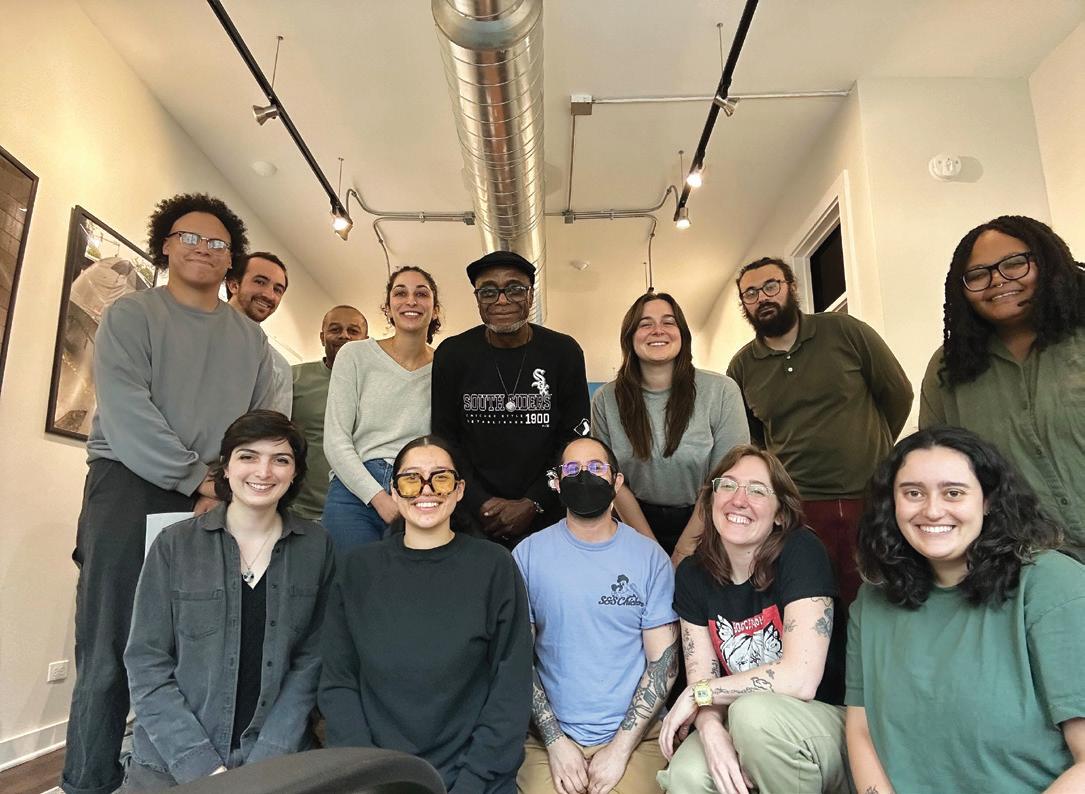
The Uptown Workers Union (UWU) is accusing its employer, the Uptown People’s Law Center (UPLC), of violating federal labor law by failing to bargain over recent layo s.
The union filed unfair labor practice charges with the National Labor Relations Board on November 3. The charges came exactly a month after the community law firm laid off
UPLC management has been represented by notorious corporate law firm Jones Day, whose lawyers provide “union avoidance” services (and helped Trump try to overturn an election). The bargaining team is still trying to discuss severance, rehiring terms, and workloads, and has yet to begin contract negotiations. UPLC’s advocates have defended the struggle of poor and working-class Chicagoans for over 40 years; yet, according to UWU’s
Notably, Johnson’s budget proposal includes funding for almost one thousand unfilled CPD positions, despite calls from community groups to redirect some of that money to policing alternatives, such as youth employment, nonpolice responders, and public mental health centers. —SHAWN MULCAHY v
Make It Make Sense is a weekly column about what’s happening and why it matters.
m smulcahy@chicagoreader.com
An anti-ICE rally outside the FBI fi eld offi ce on November 9, 2025 PAUL GOYETTE/FLICKR VIA CC BY 4.0
Members of Uptown Workers’ Union UWU


Drinks
How immigrants shaped Chicago’s bar scene
The city’s drinking culture was forged in immigrant-owned, 19th-century saloons and taverns.
By TARA MOBASHER
Liz Garibay’s first sip of alcohol was horrific. “It’s funny to look back on,” said Garibay, who is now the founder and executive director of the Beer Culture Center in Chicago.
But soon, she found herself going to bars alone to study, read, watch a game, or have dinner. “Going to these spaces made me realize how important those bars were to creating community and the value in being a regular at a bar,” she said. “For Chicago, it’s part of our heritage.”
Chicago became a hub for beer brewing in the 19th century. By 1900, the city had around 60 breweries, thanks to an influx of German and Irish immigrants who brought with them lighter, more carbonated lagers.
From the popular (but often-avoided) Malört to the vibrant social atmosphere of bustling pubs and taverns, immigrants integrated deep into the fabric of the city.
Garibay said new arrivals to the city were largely drawn to these spaces because of the sense of community they found. “They want to be in spaces where other people speak their language, wear their clothes, understand their cultural background,” Garibay said.
One of the reasons so many taverns were owned by immigrants, Garibay said, was that liquor licenses were easier to obtain in Chicago compared to other cities. “You can just find four walls and do your thing,” Garibay said. European immigrants in need of work often obtained a tavern license to provide for themselves and their families. Incidentally,
Immigrants’ influence on Chicago is ever-present in the alcohol we drink, the food we eat, the music we listen to, and the books we read.

they also found new social and cultural circles. “Human beings naturally gravitate and want to be with people who are like them,” Garibay said. “They’re coming straight from di erent parts of Europe or di erent parts of the world.”
The new communities, Garibay said, often used taverns as spaces to socialize, relax, and sometimes network. They spoke similar languages, bonded over traditional food and music, and discussed news from back home.
Michael Roper, current owner of Hopleaf Bar in Andersonville, notes how types of alcohol and traditions followed communities wherever they settled.
He bought the bar in 1992 from Swedish immigrant Hans Gotling. Gotling became wellknown for making and selling Swedish glögg, a mulled wine that is particularly popular during the holidays. It was so beloved that people would drive from 50 or 60 miles away for it.
Roper said the unlicensed production and sale of the wine was illegal, but because Gotling was a Democratic precinct captain at the time, he was largely safe from punishment. After he sold the bar, Gotling also sold the glögg recipe to a Minneapolis distiller. “Frankly, it was never the same if he didn’t make it himself,” Roper said. “It wasn’t as good.”
Immigrants’ involvement in the Chicago alcohol industry can even be traced back to the city’s first riot in 1855. The Lager Beer Riot began when anti-immigrant mayor Levi Boone targeted the predominantly immigrant-owned bars. He enforced an ordinance mandating taverns be closed on Sundays and raised the cost of liquor licenses from $50 to $300 per year.
The move was not met well by German immigrants, who worked six days per week, allowing themselves Sundays to socialize—typically at local taverns. They fought around the downtown area for immigrant rights, politics, and beer. The City Council ultimately agreed
Grandma’s Saloon, 211 E. 22nd, in 1906



of a bar at 29th and Federal in the 1910s
to lower the fee, dropping it from $300 to $100. It also voted against releasing those who were jailed for not paying the fine.
But drinking was still preserved as a common aspect of European and Chicago culture. “Most of the immigrants of the 20th century in the United States came from places where alcohol was part of their national culture,” Roper said.
Those traditions also furthered anti-immigrant sentiment against Irish and German communities across the country in the mid-19th century, perpetuating stereotypes that they were drunks and criminals.
Now, neighborhoods like Andersonville, which was once majoritySwedish, have changed as new communities moved in. “The few Swedes left are pretty old, and most of the Swedish businesses in the neighborhood have disappeared. It’s a more mixed neighborhood now,” Roper said.
“More Hispanics, more people from the Middle East. But ethnically, it still retains some of the identity of being a Swedish immigrant neighborhood.”
Even still, immigrants’ influence on Chicago is ever-present in the alcohol we drink, the food we eat, the music we listen to, and the books we read. “Immigrants have not only shaped Chicago,” Garibay said, “but they shaped the way we drink [and] taught us how fighting for something you believe in can cause significant positive change, be a catalyst for change, and can influence the way you actually look at life.” v
m letters@chicagoreader.com

ARTS & CULTURE
CRAFT WORK
‘ S ee ing the world in bead color’
Yuliya Klochan’s beading practice taps into her Ukrainian roots.
By RUBY ROSENTHAL

A work in progress on the artist’s loom COURTESY THE ARTIST
Two years ago, beading artist Yuliya Klochan was a prolific writer, armed with a newly minted master’s from Northwestern’s Medill School of Journalism. At the American Society of Gene & Cell Therapy, she was up for a promotion to senior communications manager: a shiny new title for a shiny new stage of life.
This was it, right? She’d made it. But then she realized she couldn’t stay awake during half the day she was supposed to be working. She learned she has a chronic sleep disorder, and that it would be impossible to work a traditional nine-to-five. So she grieved. And she created new traditions, including a beading practice, tapping into her Ukrainian roots.
Then one afternoon earlier this year, Klochan was strolling around “That’s What She Said,” an exhibition of women’s art at Jackson Junge Gallery in Wicker Park. Hanging on the walls, she saw crushed eggshells and dried roots in Conversations With My Mother by Doina Mihaela Iacob, robin eggs captive in a gumball machine, and a bird perched pen-
pants, Klochan tells me that before she emigrated from Ukraine at age 14, she learned loom beading in a class called “labor,” which is equivalent to home ec in the U.S. Boys and girls are separated; boys make wooden stools, and girls sew skirts and learn how to cook. Fun?
“Nobody was into this class,” Klochan remembers.
So Klochan began by cross-stitching reproductions, purchasing patterns she found on Etsy made by other Ukrainians. Then, in July 2023, she began beading. A little over a year in, the owner at Artem in Evanston—the first gallery to accept her framed beaded art and allow her to bring whatever she wanted—told Klochan she should raise her prices.
Now, her work hangs at Jackson Junge, Andersonville Galleria, Chicago Fine Art Salon. And You’d Look Prettier If You Smiled More is sold out on her website.
sively outside in the sculpture Anybody Got a Quarter? by Deana Bada Maloney. It was complex, political, moving. But she certainly couldn’t create something like that, she told her husband. “Why not?” he asked.
Klochan now hunches over a loom for hours, her cats Clunk and Strawberry afoot, creating beadwork about a world she wishes existed. That world has equal rights, LGBTQ+ pride. It’s without men chastising women to smile, like in her 2,560-bead piece of an orange-haired woman. Her eyes are closed, mascara dripping down her face while she applies garnetcolored lipstick to barely upturned lips, called You’d Look Prettier If You Smiled More—it’s the first piece she created that really felt like “her.” Could this be it?
Klochan is 29 years old. She has shoulder-length bouncy red curls, brown eyes transforming into half-moons when she smiles, and a soft laugh. Midway through our interview, she pops open her fridge door (a mosaic of pig-themed magnets from around the world) and hands me a fuchsia can of Bubly seltzer. As I wipe condensation on my
It’s an experience she describes as “seeing the world in bead color.”

“I started because I wanted a hobby,” Klochan says. “As an adult, I’ve never had a chill, nonmoney-producing, nonside-hustle hobby.”


That didn’t exactly go as planned. Her first beading reproductions were van Gogh’s Starry Night , the CTA el map, and Munch’s The Scream . Then, the originals: portrayals of queer love, nonbinary and Ukrainian American pride, and subversions of myths; women’s issues, like Pro-Choice , depicting a partially nude woman with flowers covering her vagina, or Double the Hours of Housework Per Week , where a woman waves her right hand as she holds a baby in her left, one foot in the o ce, one foot at home.
Artist Yuliya Klochan’s labor-intensive bead works take hours to create.
Though she now makes art with a four-inch needle instead of a pen, Klochan still uses her writer’s brain when creating characters in her beadwork, using color to develop their personalities. Sitting atop her desk is a small plastic chest of drawers filled with Toho Aiko beads, labeled by color combinations: red, pink, and orange; green, purple, and brown; colors making up the Ukrainian flag. She used an iridescent white, for example, in Magic Wand , where a woman donning a black-andwhite leotard directs a wand toward a splatter of silvery gray, using the shimmering white and her shiniest black beads to highlight playfulness. Its background is also a particular blue—a matte, washed-out cobalt to make it look like a vintage pinup model poster. She also maintains an entire box of white beads and a whole box of brown, to get hair just right. But what really matters to Klochan is when what she’s made resonates with people.
And sometimes, she’ll spy a brief instance of beauty—like in A Sunset Moment, where a couple wearing fluorescent pink shorts capture a smartphone photo of the sun slinking into peach-colored clouds—snap her own discreet photograph, and later use it as inspiration.
“A Ukrainian family noticed my piece Ukrainian-American , which describes the struggle of having two worlds,” Klochan says. “There was a little kid, maybe like five years old, and his mom said to him, ‘This is you.’ It was just so powerful to me—that it was applicable to such a wide range [of experiences] even though it was a personal piece.” I think she’s found it. I think this is it. v
m letters@chicagoreader.com
ARTS & CULTURE

EXHIBITIONS
RAn exhibition worth revisiting Temitayo Ogunbiyi’s poetic approaches to geography.
Tracing a journey from Lagos, Nigeria, to Chicago, Temitayo Ogunbiyi’s “You will have revelations along felled branches and longer roots/routes” at the Arts Club of Chicago is a pursuit into the ecological life found within each environment. Attuned to the healing properties of botanical forms native to either region, the transnational exchange results in a series of drawings, paintings, and sculptures that stand out for their quiet but steady captivation.
The exhibition, which forms one position of the artist’s spate of public programming this fall, relies mischievously on viewer engagement to accentuate its full potential. Utilizing vintage furniture as display and storage containers, Ogunbiyi’s installation, You will find new framings in cra s of old, is placed within closed drawers and, sometimes, underneath the furnishings themselves. To access them, viewers are invited to interact carefully, a process that only helps to pull attention to the intricate detail of Ogunbiyi’s botanical studies, mixed media on herbarium paper that are reminiscent of early scientific illustrations.
In aesthetic contrast, a vast array of paintings, almost all created from varnished Japanese ink and acrylic on found fabric, enlarge and enliven the flora tucked away. Pale hues offer so depictions of plant life, while sculptural works inside and outside the gallery shimmer with cultural and material vibrancy.
Positioned across linguistic, formal, and conceptual assemblages, Ogunbiyi creates a network of meaning filtered through poetic approaches to geography. There is, invariably, no way to glean all the rich knowledge on display. But perhaps this is best: an invitation to return to the venue and (re)learn about relationships unfamiliar, connections that can only blossom and grow with time, as the artist intended. —LUCAS GÓMEZ-DOYLE “You will have revelations along felled branches and longer roots/routes” Through 12/19: Tue–Fri 11 AM–6 PM, Sat 11 AM–3 PM, Arts Club of Chicago, 201 E. Ontario, artsclubchicago.org/exhibit/4967
RThe
future is here
At the Art Institute of Chicago, Diane Simpson builds herself into the heart of the city.
In her 90th year, Diane Simpson, a Chicago legend, presents work inspired by time. With a decades-long practice in the fields of art, design, and architecture, Simpson’s cra is a tour de force, demonstrating the multiplicity of creation, form, and perspective.

For the first time in her career, Simpson’s sculptural works are shown outside, gracing the Bluhm Family Terrace at the Art Institute of Chicago. Rendered from preparatory sketches developed in the 1980s, on which the artist had inscribed “Good for Future,” the three newly commissioned sculptures on view come to life. With the future now here, Simpson has materialized the past; the works are a testament to patience, a celebration of longevity, and a reminder that dreaming builds far more durable foundations than the unstable base of immediate impulses.
Set against a portion of the Chicago skyline and overlooking the Lurie Garden, the sculptures are geometric siblings to their surrounding urban environment. Each work, fabricated from medium-density fibreboard and painted with acrylic, is a semi-optical illusion, a product of Simpson’s translational style between twoand three-dimensional space, resulting in a perspectival flattening of the objects. To break from this transfixing spell requires viewers to shi around the site, in turn activating the works, which are animated by a play between light, form, and color. From some angles, the shapes look joyfully animalistic, while in other sight lines they more closely resemble miniature sci-fiesque constructs.
In either case, the result is wonderfully interactive— outcomes achieved only through the complementary coexistence of objects, people, and space. Surrounded by the bustle and cacophony of city sounds, Simpson has built herself into the heart of Chicago. —LUCAS GÓMEZ-DOYLE “DIANE SIMPSON: ‘GOOD FOR FUTURE’” Through 4/19/26: Fri–Mon and Wed 11 AM–5 PM, Thu 11 AM–8 PM, Art Institute of Chicago, 111 S. Michigan, artic.edu/exhibitions/10630/dianesimpson-good-for-future, adults $20–32, seniors 65+, students, and teens 14–17 $14–26, children under 14 and Chicago teens 14–17 free v
EXPLORE HOLIDAY ITINERARIES, EVENTS, DEALS AND MORE AT


A Musical Adaptation of William Shakespeare’s As You Like It
Adapted by Shaina Taub and Laurie Woolery
Music and Lyrics by Shaina Taub
Directed by Braden Abraham
Music Direction by Michael Mahler
Choreography by Erin Kilmurray



Top: Temitayo Ogunbiyi, Arts Club of Chicago; Diane Simpson, Art Institute of Chicago
TOP: MICHAEL TROPEA; COURTESY THE ART INSTITUTE OF CHICAGO


Drinks
Belly up to the theater
Drinking shows can be fun but require ground rules and common sense.
By KERRY REID
Drinking and theater have always gone together, from the winesoaked festivals of Dionysus in ancient Greece to the boisterous ale-enhanced behavior of the groundlings during Shakespeare’s plays at the Globe Theatre. Plays set in bars have also stood tall (or staggered) throughout the modern canon, from Eugene O’Neill’s epic The Iceman Cometh (which Reader critic Tony Adler called “a masterpiece of excess”) to William Saroyan’s The Time of Your Life to Conor McPherson’s The Weir (a collection of ghost stories told by characters in an Irish pub).
The camaraderie of bar culture extends o stage for many actors, though most of the time they save their imbibing for after the show. (John Barrymore of the legendary acting clan being a famous—and tragic—exception.)
But there are shows where actors and audiences are encouraged to enjoy cocktails while the story plays out. Recently, I saw Drunk Dracula at the Lion Theatre downtown (also the home of the long-running Drunk Shakespeare), wherein an actor is selected at the top of the show to down several shots (and may drink more during the performance) and then has to make it through the material. When the artists of Drunk Shakespeare went union a couple of years ago, I asked company member and organizer Diego Salinas how they protect the designated drinker at each show. He told me, “We have robust systems in place to make sure that our drunk actor is taken care of before, during, and after the show. We are all in rotation to make sure everyone’s liver gets a break. And we make sure our actor goes home in an Uber or Lyft or a cab at the end of the night.”

Hitch*Cocktails
have in some way featured alcohol as a component of the action to find out how they walk the line between fun and mayhem, and how they protect the artists and audiences from the consequences of excessive boozing.
Open run, Fri 9:30 PM, Annoyance Theatre, 851 W. Belmont, 773 - 697-9693, theannoyance.com, $22
There’s a drinking game for the audience to play that all is based o things we do or say onstage triggering your drinking, if you would like to participate.” Additionally, there’s a game for the actors. “If an actor o ers another a drink from the onstage bar, the actor must accept that drink and must finish the drink before the scene finishes,” says Fitzpatrick. Fitzpatrick says that her training in intimacy direction means that she is focused on “consent-forward practices” for performers. Actors can opt out of drinking and be the night’s “designated improviser,” meaning they’ll stay sober and make sure that things don’t get off the rails for either the cast or the audience.
Additionally, notes Fitzpatrick, “We have two shorthand signals—one that’s verbal and one that is physical—that tell the other actors onstage, ‘I’m not OK with what is happening to me right now.’
So it might be that you get served a drink, but you’re like, ‘I’m absolutely not gonna drink this.’ You can use one of those signals, and we know somebody else is gonna swoop in and take that drink from you. Or it might be that you were the designated improviser and somebody accidentally served you an alcoholic drink, and you can use those signals as well.”
and Kerouac and Dorothy Parker.”
The show took shape as an examination of “the connection between creativity and alcohol,” and opened in its first incarnation in fall 2002 with Mosqueda, Benjamin, and fellow Neo-Futurist Diana Slickman at the nowclosed T’s Bar in Andersonville, where, as their website describes it, “We sat at the bar and drank and talked about famous drinkers and writers, our drinking and writing, the e ects of alcohol on the body and mind and family, and we drank . . . more.”
The first show was a hit, leading to further chapters exploring Prohibition-era writers, hangover cures, and even holiday shows (The 12 Steps of Christmas , A Beer Carol ). Along the way, the Drinking & Writing Theater also supported local brewers through the Beerfly Alley Fight competition, featuring craft brewers, art, and food, and moved into film with the Tied House Film Festival, where filmmakers created short films on “the 5 stages of intoxication.”
O cially, Drinking & Writing works under the umbrella of Tied House Productions, which Mosqueda says is both a nod to the history of tied houses in Chicago (saloons owned by brewing companies— Schubas started out as one such establishment) and a way to apply for funding with a name that might be a little less o -putting. But Mosqueda says they don’t shy away from the alcohol-friendly nature of the shows. “If someone is offended or a venue is offended by what we do, then, you know, we move on and drink somewhere else.”
I recently checked in with other shows that
Hitch*Cocktails from High Stakes Productions operates in a somewhat similar fashion to Drunk Shakespeare but is entirely improvised. Bri Fitzpatrick, the intimacy director and culture coordinator for High Stakes, notes that Hitch*Cocktails begins with a suggestion of a fear from the audience. “We want it to be a fear that an audience member believes is unique to them and them alone, and then we improvise a two-act Hitchcockian thriller.
It’s not hard to figure out the focus of the long-running (albeit produced intermittently) show Drinking & Writing . Cocreators Sean Benjamin and Steve Mosqueda met while company members of the Neo-Futurists. As Mosqueda tells it, “After the shows we hung out in bars a lot. We were hanging out at Simon’s one night . . . thinking about doing a show about Charles Bukowski. We were gonna call it Buk on Ice, and it was gonna be a show with ice skating and Charles Bukowski. So that was the first idea. And then as we were doing research, we just learned that there were just too many writers to not involve everybody. You know, we got Hemingway and Fitzgerald

As for blending their own creative processes with booze, Mosqueda says drinking makes it “easier to come up with the ideas. But then again—I mean, this is kind of a cliche now—when drunks write, they write it down and then they wake up the next morning and realize it’s crap. But within that crap, there’s little nuggets that you can pull out of there.”
Mosqueda says that the “writing” part in Drinking & Writing inspires its own fandom, where people will reach out with suggestions. “‘Have you ever read this by Bukowski, or Kerouac?’” Bars even haunt his subconscious:
DRINK: AT THE ARCADE!
Fri–Sat 11/ 14 -11/ 15 7:30 PM, Cornservatory, 4210
N. Lincoln, cornservatory.org, $11-$ 30
Mosqueda’s latest work in development, the musical Miersten Wolf, comes from a dream he had in the pandemic about an encounter with a mysterious woman at a bar. (The company is hoping to open the show mid-February 2026.)
And yes, sometimes there are patrons who take the audience participation and imbibing too far. But Mosqueda notes that the Neo-Futurist training helped them learn how to deal with it. The shows back then ran at 11:30, and Mosqueda says, “People would show up drunk off their ass.” If anyone got out of pocket, Mosqueda says, the cast would “stop in the middle of it and say, ‘Hey, can you stop?’ And nine times outta ten, it would embarrass the hell out of them. And they’d shut up or they’d leave, which is great.”
Corn Productions also has a lot of experience dealing with drunk audiences. After all, they’ve encouraged it for years with their holiday-themed drinking-game sketch productions, like Death Toll: A Halloween Drinking Game Performance , the Christmas-themed Happy Holly-Daze , and the Saint Patrick’s–themed O the Paddy Wagon. Currently, they’re running DRINK: At the Ar-
game.” Lance notes sometimes the game remains consistent throughout the show, and other times the rules change over the course of the performance.
Lance notes that when the shows first started, there would be a “designated drinker” onstage. “The first time I was dubbed the drinker, I realized I should be taking tiny sips far too late and was, uh, quite drunk for the show. Made it through, just barely.” Now, says Lance, the actors mostly avoid drinking, which helps with crowd control.
Another element that helps things go smoothly is that Corn has a designated host for each show, who explains the rules of the game (drink anytime someone sings, for example). A light-up “DRINK” sign reminds people as well, but Lance says that they emphasize that moderation is key. And there is also the all-important “don’t be an asshole” rule. “We basically explain, ‘Hey, the show’s up here; it’s not out there for the next hour and a half. We’re a lot funnier than however funny you think you are.’”
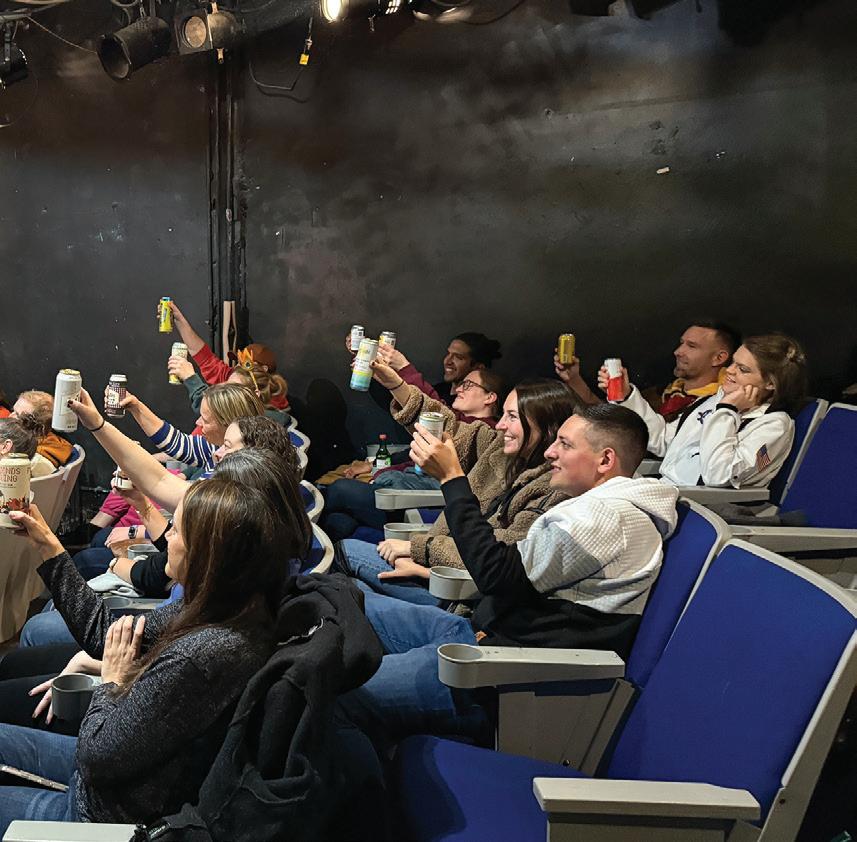
There is also the allimportant “don’t be an asshole” rule.
cade!, built around themes from video games. Though the company doesn’t have a bar onsite, they’ve also long encouraged BYOB for patrons.
Artistic director Justin Oliver Lance (who is married to managing director Deanna DeMay) says that the BYOB aesthetic evolved into the drinking-game shows. “We used to always call it the cheapest date night that you could find in Chicago. We really embraced the idea of having a sketch show where there’s a drinking
Drinks



are not drinking. We’ve had plenty of people who don’t drink come to see the show. It’s an element of the show that people really, really enjoy, but it’s by no means necessary to be able to enjoy the show.”
Even if, like Cassio in Shakespeare’s Othello, you have “poor and unhappy brains for drink-
DeMay says that having an earlier start time than in the past means they’re getting people at the beginning of their night, rather than patrons who are already three sheets by the time they get in the door.
As for the creative process for the sketches, DeMay says, “When people are writing sketches, we’re not telling them to write with any game in mind. We’re like, ‘Here’s the theme of the sketch show. Just write something. We’ll figure out a game.’”
With drinking, however, unpredictable behavior follows. DeMay says that her favorite incident involved an audience member ordering a pizza during the Saint Patrick’s show. The host, Lindsay Bartlett (who performs her duties in character as Bono), managed to shame the patron into giving up a slice or two for interrupting the performance when the (unpaid) delivery arrived. DeMay and Lance also say that, while it’s not commonplace, there are people who don’t know their limits, which is why they emphasize where to find the bathroom at the top of the show.
Everyone I talked to stressed that they want sober audiences to be able to enjoy their shows as well. Fitzpatrick says, “We have had underage folks come to the show before who
ing,” it’s possible to take in these shows with clear eyes—and gain a fresh appreciation for the skills artists need to make the connection between the stage and audience, sober or otherwise. v
m kreid@chicagoreader.com

The audience at Death Toll COURTESY CORN PRODUCTIONS
Drinking & Writing (Steve Mosqueda at far right) COURTESY THE ARTIST
THEATER
OPENING
RThe enchantment of love Writers Theatre’s As You Like It sings the joys of redemption.
In recent times, our greatly imperfect union has seen the eruption of hatred from human to human. At first, As You Like It seems like more of the same: two pairs of brothers—Oliver and Orlando, and Duke Frederick and Duke Senior—each determined to outlast the other by any means necessary. Orlando (Benjamin Mathew), raised in a humble speakeasy by servant Adam (Torrey Hanson) and firm to prove his inborn honor, enters Duke Frederick’s wrestling match. A nasty fight ensues, Orlando prevails—and finds that there is no winning: Like Duke Senior before him, the man is banished. Intolerant of all he imagines opposed to his rule, Duke Frederick (Scott Aiello) decides that his niece, Rosalind (Phoebe González), daughter of Senior and erstwhile companion to his own daughter, Celia (Andrea San Miguel), must also go. But whither ought these fair youths wander? There is but one place: the forest of Arden.
Sophie Haviland in 2000. Director Seph Mozes staged the production at the United Church of Rogers Park (it was the first time Foreman’s work had been performed in Chicago in 30 years). The play is about two gay men trapped in a labyrinth pursuing a Minotaur. The labyrinth
candlestick maker, will be instantly relatable to anyone who’s dealt with the literary world in any way, shape, or form.
The highlight of the entire play is a wordless pantomime of the townsfolk demonstrating in increasingly erotic/ridiculous gestures the techniques by which they scrawl away at their masterpieces.
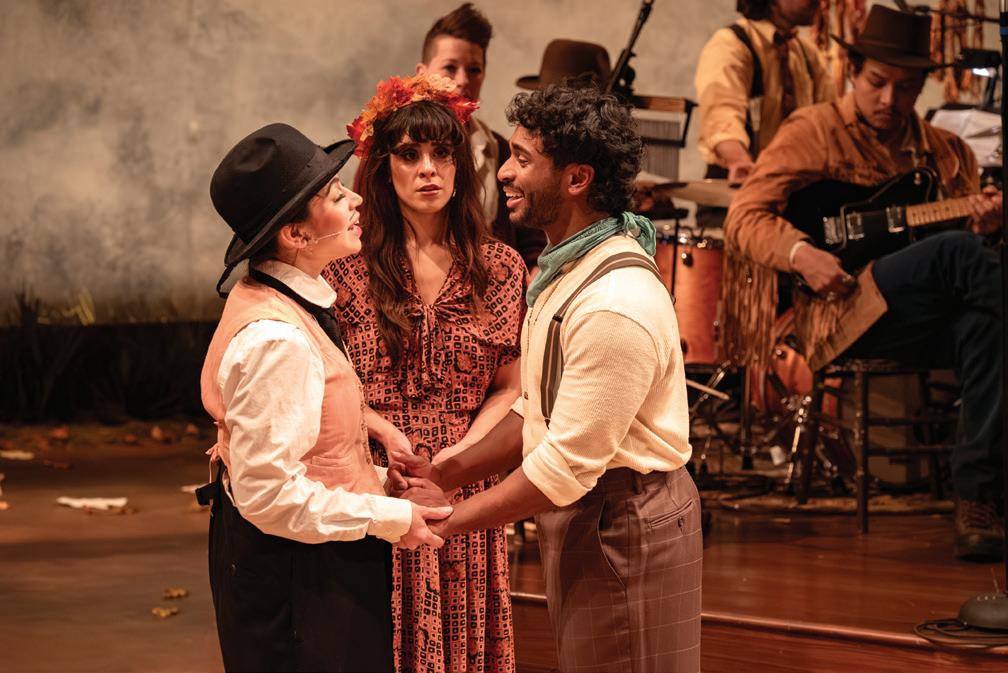
The joke, of course, is on each and every one of us who has ever tried to make anything at all.
Because even the most cynical, world-weary wretch harbors a tiny flicker of a dream that fools them into continuing the most hopeless pursuits. This one’s funny because it’s true.
—DMITRY SAMAROV A DEVIL COMES TO TOWN Through 12/6: Thu–Sat 8 PM; Trap Door Theatre, 1655 W. Cortland, 773-3840494, trapdoortheatre.com, $22
Elegy for broken children
The 4th Graders Present an Unnamed Love-Suicide looks at the horrors of prepubescence.
If you know kids, you know that everything they think and feel lives close to the surface.
“Johnny wrote this before he shot himself,” a boy mutters into a microphone at the beginning of a school assembly. Johnny’s play is a theatrical suicide note, loaded with the dead boy’s observations of his class’s social dynamics and dramatizations of his own regrets. Johnny was clearly preoccupied with the nature of goodness, the ways he hurts his “girlfriend,” Rachel (Charlee Amacher, heartbreaking), and how his peers (including a terrifying Quinn Leary as a sociopathic bully) hurt him, leaving him to ask if there’s any good le at all.
Writers Theatre’s production of the musical adaptation of Shakespeare’s play by Shaina Taub and Laurie Woolery, directed by Braden Abraham, with music direction by Michael Mahler and choreography by Erin Kilmurray, is crackling, sharp, and radiant. The enchantment of love is articulated plausibly through poppy, happy songs that will follow you home, sung, danced, and acted by a collective that offers redemption in their very being. Life-affirming, love-affirming, and deeply, beautifully joyful—we need such antidotes to remind us of the magic that remains with us in small and large acts of generosity. —IRENE HSAIO AS YOU LIKE IT Through 12/14: Wed 2 and 7:30 PM, Thu–Fri 7:30 PM, Sat 2 and 7:30 PM, Sun 2 and 7 PM; Wed 11/12 and 12/10 7:30 PM only, Sun 11/23 2 PM only, no show Thu 11/27, Fri 11/28 2 PM only; open captions Thu 11/20, ASL interpretation Sat 11/22 2 PM; Writers Theatre, 325 Tudor Ct., Glencoe, 847-242-6000, writerstheatre. org, $45-$125, pay what you can Sun 11/30
RRichard Foreman lives Bad Behavior illustrates the queerness in the late artist’s work.
Late playwright Richard Foreman used to describe his performances as “ordeals.” Until his passing earlier this year, he spent almost seven decades in New York’s avant-garde theater scene, where he distinguished himself for rejecting most conventional theater rules. He became involved in the New York underground not long a er moving to the city with his MFA from the Yale School of Drama. One of his earliest New York experiences was witnessing police shut down a screening of Jack Smith’s Flaming Creatures and arrest its three organizers on obscenity charges. Of the trio, one became his lifelong friend and among his first collaborators, helping him kick-start a career marked by tackling complex themes with a bare-bones, raw aesthetic and a Dada writing style (Foreman was a big fan of the cut-up method).
Last week concluded a three-week run of Bad Behavior, a Foreman production cowritten with mentee
is a realization of their unconscious minds and relationship quarrels. The parts are played by seven people—in this case, a visibly genderqueer cast (Cal Kreiner, Felix Flores, Fionn Casper-Strauss, Joel Cordova, Alberto Arizmendi, Seth Nguyen, and Zachary Feuling) whose varying proximities to masculinity emphasize the link between gayness and transness. In keeping with Foreman’s rule-breaking, minimalist ethos, the audience was seated onstage while the floor was used to imply the labyrinth via a grid created from black sound blankets. Over the course of an hour, the story settled like a loose dusting of childhood memories, lovers’ promises and betrayals, and soul excavations. It’s an abstract play that’s not easy to follow—but the moments that hit for me all felt wondrous and profound.
In 2024, Mozes staged a reading of the play at Facility Theatre to raise funds for the production, and earlier this year, he directed several shorts by Gertrude Stein, a huge aesthetic influence on Foreman. Mozes is an early career dramaturg excited by the legacies of some of theater’s most notable conceptual playwrights and seems to slowly be adapting their works in ways that emphasize the queerness of their visions. As someone so devoted to the subversive theater archives, it’ll be interesting to see where his first self-written production goes.
—MICCO CAPORALE
RFunny because it’s true
In A Devil Comes to Town, the joke’s on anyone who’s ever tried to create.
Jeremy Ohringer adapts and directs Paolo Maurensig’s 2019 dark comedic novel about how ambition can overwhelm and eat up even the meekest, most inward among us. The story is nominally set in two small towns—one hosting a psychoanalysis conference, the other overrun by aspiring writers lured by its claim to fame that Goethe might’ve stayed there one night. The true setting, though, is the overheated imagination of just about any writer you’ve ever met.
Told in a slippery, swapping manner where all five cast members are billed as Father Cornelius (though each takes turns mouthing the lines of all the townsfolk), the story of the devil arriving in the guise of a publisher, promising fame and fortune to the butcher, baker, and
The emotional horror of adolescence and the archness of melodrama are linked in The 4th Graders Present an Unnamed Love-Suicide by Sean Graney (founder and artistic director of the now-gone Chicago company the Hypocrites), which uses broad comedy and high drama to cry out in grief. (The play premiered at the Side Project in 2003.)
As Johnny (or more accurately, the boy playing the dead Johnny), Antonio Cruz is tightly coiled, all squints and mumbles, and the entire ensemble’s juvenile physicality is spot-on. The production itself has some calibration issues, however. Johnny’s text (via Graney) is splintered and awkward, at odds with the realism of many of the performances. Despite this dissonance, Hannah Ottenfeld’s direction for Bump in the Night de ly handles the play’s design elements. Throughout, an unnamed character watches the action from the side, singing hymns and scribbling in a notebook. At one point, they scrawl a Bible verse on the upstage blackboard that warns against repeating violent cycles. The 4th Graders is a brutal trip through the ten-year-old psyche, an elegy for the children broken by these cycles. —ROB SILVERMAN ASCHER THE 4TH GRADERS PRESENT AN UNNAMED LOVE-SUICIDE Through 11/30: Thu–Sat 11/20-11/22 7:30 PM, Sun 11/23 3 PM, Mon 11/24 7:30 PM, Sat 11/29 7:30 PM, Sun 11/30 3 PM; Facility Theatre, 1138 N. California, bumpinthenightchi.com, $28 ($23 Sun 11/23) v

As You Like It JENN UDONI


FILM
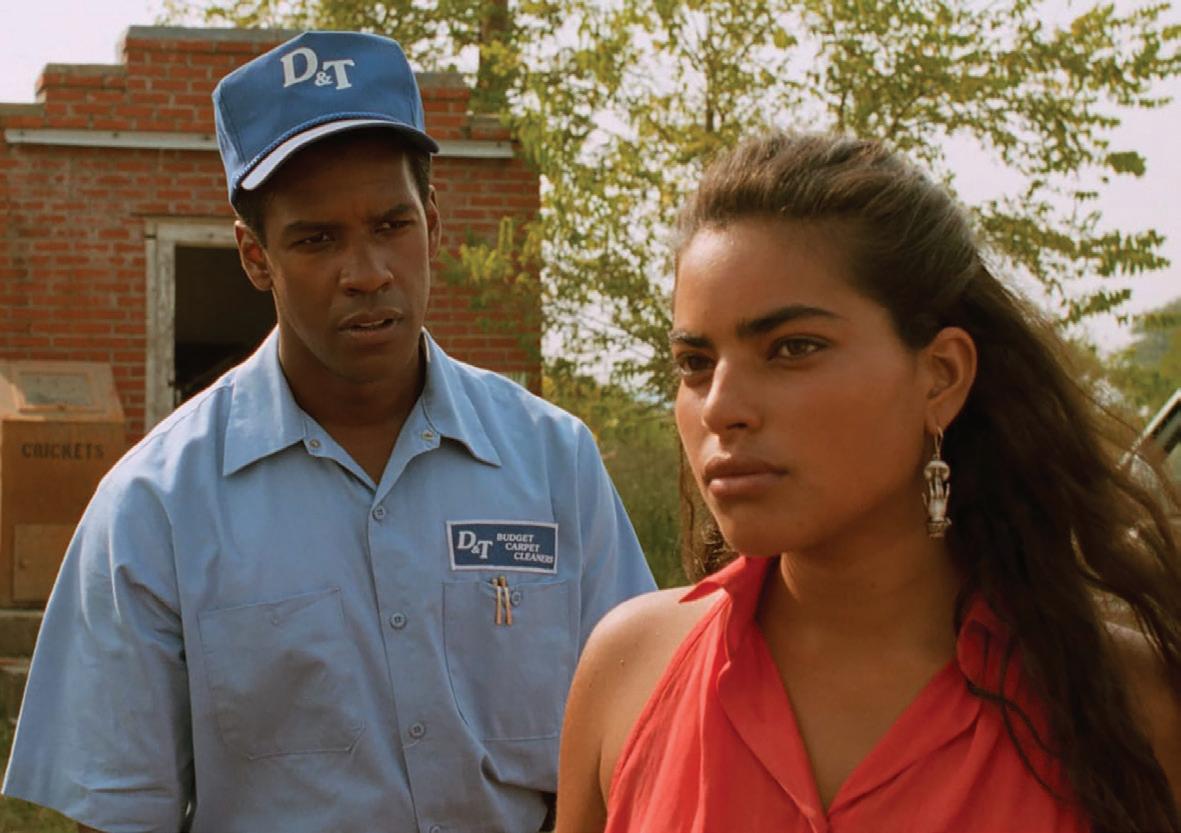


Everything comes back to cinema. Well, not everything, but a lot of things, many surprisingly so. In early November, Zohran Mamdani was voted the mayor-elect of New York City—like many, I breathed a sigh of relief, feeling hope for the first time in a long time. How this relates to movies is that Mamdani’s mother is Indian American filmmaker Mira Nair, two-time Cannes award winner and all-around trailblazer. So I celebrated Mamdani’s momentous win by watching Nair’s narrative feature Mississippi Masala (1991), which I regret not having seen before. (For those also wanting to check it out, it’s streaming on HBO Max.) It’s lush and nuanced, romantic and edifying. Its story centers partly on an Indian family who were forced to leave Uganda, where the protagonist Mina’s father had been born. (People from India had been brought over to build a railroad and stayed.) In 1972, Ugandan dictator Idi Amin exiled all South Asians from the country, hence why Mina and her family now reside in Mississippi. Mostly, though, the film is a romance between Mina (Sarita Choudhury—Seema on And Just Like That. . . for anyone wondering) and Demetrius (Denzel Washington), the racial dynamic a reflection of their families’ histories. Watching films made by women is a natural part of my moviegoing life, but this past week women animators were a particular focus. I went to the 2025 Eyeworks Experimental Animation Screening Series at Northwestern University’s Block Cinema. It’s an annual showcase of boundary-pushing animation, new and old, curated by animators Alexander Stewart and Lilli Carré and exhibited in Los Angeles, Chicago, and New York City. I always enjoy the showcase, but this year was especially gratifying. The first



A still from Mississippi Masala (1991)
film in the first program, Sandy Moore’s The Lives of Firecrackers (1979), blew me away with its cleverness. It’s di cult to describe but involves, among many other types of firecrackers, a philosophical firecracker contemplating its ephemerality.
Following that was Kate Renshaw-Lewis’s Busy Bodies (2025), which is contemporary but nevertheless felt older, a mix between Fred Wolf (1971’s The Point ) and Suzan Pitt (1979’s Asparagus ). My friend Ben Creech, who was also projecting the program, theorized on how it was animated, which made me realize that I have no idea how an experimental animation might be made. I also loved Kathryn Roake’s And a Little For Me (2024) and Priit and Olga Pärn’s Luna Rossa (2024), the latter of which made me realize I need to seek out more by Priit Pärn, a 79-year-old Estonian cartoonist whose recent work, made with his wife, Olga, still manages to stay on the cutting edge of animation.
In the second program, I was taken with Caroline Leaf and Veronika Soul’s Interview (1979), a short, live-action animated documentary about the two filmmakers, their friendship, and their work, giving verve to the idea that the personal is political with how revolutionary it was for its time. Though not made by a woman, I also really liked Mike Lopez’s Friends, Shopping, and Food (2025). Lopez is a local filmmaker and, transparently, a friend, but I was blown away by it, especially because I know him—I had no idea this is where his practice could go.
Until next time, moviegoers. —KAT SACHS v
The Moviegoer is the diary of a local film bu , collecting the best of what Chicago’s independent and underground film scene has to o er.
NOW PLAYING
RPredator: Badlands
Predator: Badlands is the first Predator film to be rated PG-13 rather than R. That’s a surprise for the new entry in a franchise centered on an alien species whose whole deal includes flaying bodies and plasma cannons that regularly fill the screen with viscera. What’s more surprising is that Badlands is the first time a yautja (as the creatures are called) is a thinking and feeling protagonist.
Dek (Dimitrius Schuster-Koloamatangi) hasn’t just been abandoned by his clan, he’s been cast out by his father for his apparent weakness. So when Dek travels to the most dangerous planet in the galaxy to kill an unkillable beast, he’s not just doing so for pride; he’s doing it to show daddy he’s good enough. These aren’t complicated emotional stakes, but they’re far more than these movie monsters have been afforded before.
Writer–director Dan Trachtenberg (creative leader of the franchise and codirector of the delightful animated anthology Predator: Killer of Killers earlier this year) adds to Dek’s emotional arc with the introduction of Thia (Elle Fanning), a fast-talking and emotionally intelligent (so she can better exploit organic lifeforms) android le behind by her crew. Fanning is essentially a more endearing, less annoying Donkey to Dek’s Shrek, as she’s there to teach him that friendship isn’t weakness. It’s a lesson that’s given some interesting thematic he , as Dek initially only agrees to bring her along because he rationalizes she’s a tool to be used.
The family house becomes a point of reunion when sisters Nora (Renate Reinsve) and Agnes (Inga Ibsdotter Lilleaas) return for their mother’s funeral. Their father, Gustav Borg (Stellan Skarsgård)—a renowned film director—reappears a er years of estrangement. Soon a er, Gustav confides in Nora, now a celebrated stage actress o en paralyzed by stage fright, that he’s written a new film and wants her to play the lead. In that exchange, Trier begins to expose Gustav’s emotional paralysis: He’s a man who can only articulate his remorse through art.
Gustav tells Nora that he wrote the new script specifically for her. As Sentimental Value unravels its knotted family traumas, Trier charts how Gustav’s mother

(Vilde Søyland) was persecuted during the Nazi occupation of Oslo, leading to her suicide during the director’s childhood. Gustav’s fixation on Nora playing the lead carries traces of the past, as he recognizes in her the same melancholy that once shadowed his mother.
When Thia’s crew of other Weyland-Yutani (the corporation from the Alien franchise) androids returns for their bioproducts, the exploration of what becomes a web of exploitative relationships makes Badlands a better Alien movie than the last Alien movie we got. But more than anything, Badlands is a teen-friendly adventure movie in the vein of the original Star Wars and Pirates of the Caribbean trilogies. It’s bursting with astonishing blends of practical and digital effects, thrilling action, beautifully shot vistas, and equally heartfelt and humorous character dynamics. It may be unlike any other Predator movie, but it’s all the better for it. —KYLE LOGAN PG-13, 107 min. Wide release in theaters
RSentimental Value
Can a house bear the weight of the lives it’s held? In Sentimental Value Joachim Trier treats the home as a living record, one that continually replays the traces of the lives it has contained.
Nora, however, is unable to reconcile with her father and spurns his new script. When Gustav attends his own retrospective at a film festival, he meets the buoyant Rachel Kemp (Elle Fanning), a famous American actress, and offers her the lead role. Fanning’s warmth brings a needed levity, cutting through the film’s stern Nordic cadence and underscoring why Gustav’s attempt to stage his new film in his childhood home feels fraught from the start.
Sentimental Value taps into a universal experience—the ache of returning to one’s past. Trier de ly explores how familial trauma is held deep within the heart, unwittingly passed along by generation and through the spaces we live in. What makes Sentimental Value tender and heart-wrenching is its earnestness; it offers a clear-eyed view of how complicated regret and reconciliation can be. For the most part, Trier and his cast are laser-focused, reaching an unassuming apex during an emotional exchange between the sisters. If a house can bear the weight of its memories, Trier asks, can the family who built it do the same? —MAXWELL RABB R, 133 min. Music Box Theatre, limited release in theaters v
Predator: Badlands COURTESY 20TH CENTURY STUDIOS
THE SALT SHED THE SALT SHED THE SALT SHED THE SALT SHED THE SALT SHED THE SALT SHED THE SALT SHED THE SALT SHED THE SALT SHED THE SALT SHED THE SALT SHED THE SALT SHED THE SALT SHED THE SALT SHED THE SALT SHED THE SALT SHED THE SALT SHED SALT SHED THE SALT SHED THE SALT SHED THE SALT SHED THE SALT SHED THE SALT SHED THE SALT SHED THE SALT SHED THE SALT SHED THE SALT SHED THE SALT SHED THE SALT SHED THE SALT SHED THE SALT SHED THE SALT SHED THE SALT SHED THE SALT SHED SALT SHED THE SALT SHED THE SALT SHED THE SALT SHED THE SALT SHED THE SALT SHED THE SALT SHED THE SALT SHED THE SALT SHED THE SALT SHED THE SALT SHED THE SALT SHED THE SALT SHED THE SALT SHED THE SALT SHED THE SALT SHED THE SALT SHED THE SALT SHED THE SALT SHED THE SALT SHED THE SALT SHED THE SALT SHED THE SALT SHED THE SALT SHED THE SALT SHED THE SALT SHED THE SALT SHED THE SALT SHED THE SALT SHED THE SALT SHED THE SALT SHED THE SALT SHED THE SALT SHED THE SALT SHED SALT SHED THE SALT SHED THE SALT SHED THE SALT SHED THE SALT SHED THE SALT SHED THE SALT SHED THE SALT SHED THE SALT SHED THE SALT SHED THE SALT SHED THE SALT SHED THE SALT SHED THE SALT SHED THE SALT SHED THE SALT SHED THE SALT SHED SALT SHED THE SALT SHED THE SALT SHED THE SALT SHED THE SALT SHED THE SALT SHED THE SALT SHED THE SALT SHED THE SALT SHED THE SALT SHED THE SALT SHED THE SALT SHED THE SALT SHED THE SALT SHED THE SALT SHED THE SALT SHED THE SALT SHED THE SALT SHED THE SALT SHED THE SALT






THE SECRET HISTORY OF CHICAGO MUSIC
Charles E. Gerber sparked kids’ imaginations as host of The Magic Door
He got his big break on TV in the 70s as an elfin troubadour on a Jewish kids’ show, but his career as a singer, actor, and teacher continues to this day.
By STEVE KRAKOW
Since 2005 Plastic Crimewave (aka Steve Krakow) has used the Secret History of Chicago Music to shine a light on worthy artists with Chicago ties who’ve been forgotten, underrated, or never noticed in the first place.
This installment of the Secret History of Chicago Music is more personal than most for me. The story begins in 1977, when I was four years old—a hyper kid who often woke up early, even on weekends, and would sometimes turn on the TV in those hours whether there were any cartoons airing or not. I have hazy memories of watching a trippy live-action children’s show where an elfin troubadour emerged from a tiny acorn house.
Around 40 years later, I only remembered that the name of the show had the word “door” in it. On an ordinary record-shopping excursion, I found what looked like a private-press LP of weird downer folk—the kind of thing that usually gets my attention. Released in 1974 by Charles E. Gerber, it was called Songs From the Magic Door . When I turned the record over and read the back cover, I saw that it was music “from the award-winning CBSWBBM-TV childrens show,” and something clicked deep in my brain.
The show I’d seen as a wee tot was called The Magic Door , and it had aired on Sunday mornings from 1962 till 1982 on WBBM-TV. (A short-lived sequel called Beyond the Magic Door ran for a few years in the 80s.) I’d stumbled across the rare soundtrack LP from the show. Next I knew I had to track down Gerber, the elfin troubadour from my memory—and he turned out to be quite a magical being in his own right. I interviewed him in fits and starts
over several years, learning about his connections to many important figures in Chicago music and theater and the renown he earned in those fields.
Charles E. Gerber was born April 2, 1949, and raised in West Rogers Park, a block from Indian Boundary Park near Coyle and Rockwell. Gerber and his two older siblings attended Daniel Boone Elementary (now Mosaic School of Fine Arts), and he remembers an eighth-grade homeroom and science teacher named Mr. Corey supporting his interest in performance.
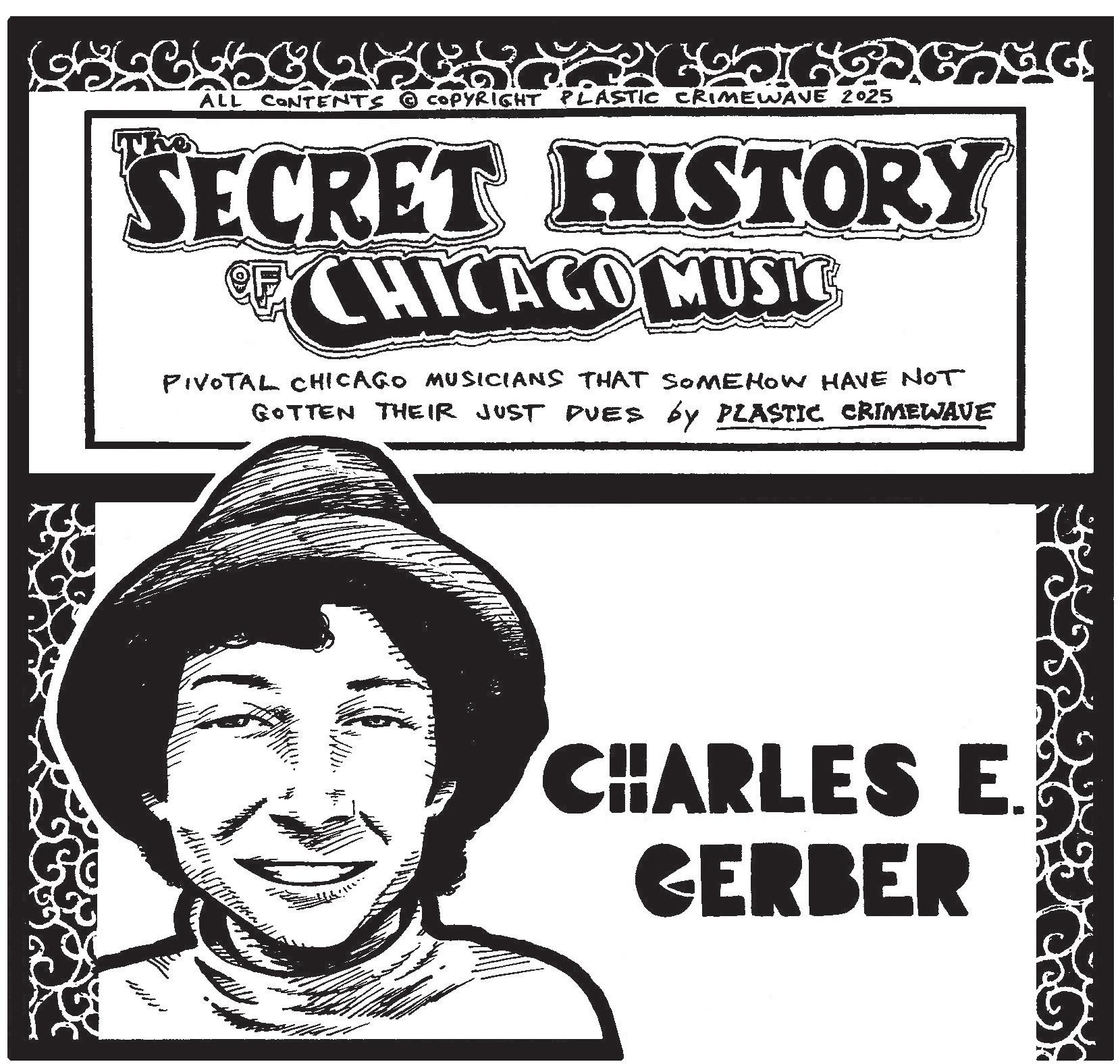
“He had me recite in class that lovely piece of quintessential American verse, ‘Casey at the Bat,’ by Ernest Lawrence Thayer,” Gerber recalls. “Mr. Corey’s instinct that I could ‘pull it o ’ and amuse my classmates, in the intended way of the poet, was somewhat prescient on his part in what would become a rather pivotal aspect of my professional career.”
At his graduation from Boone, Gerber sang “Elanoy,” which he calls a “venerable Illinois folk song,” and he remembers Mr. Corey being astonished by the beauty of his performance. “Evidently that made a lasting impression of encouragement,” Gerber says. “Such is the immeasurable power of a teacher.”
At Mather High School, Gerber got vital guidance from William “Wild Bill” Paulick, the school’s choir director. “He was bedbug crazy and something of a musical genius,” Gerber says. Paulick was so effective as a teacher that he could guide barely trained singers to prize-winning performances. “We would and
could take on Bach, Handel, Haydn, Randall Thompson, and madrigals that Shakespeare would revel in.”
Two English teachers also made huge impressions on Gerber. Joe Brown took him to a Bach performance by the Chicago Symphony Orchestra, which floored him. Thomas Daniels became a lifelong friend, such that Gerber is still in touch with his widow and kids. “It’s impossible to assess his influence on me as a student, not merely of language but all aspects of life: Shakespeare, Bob Dylan, the guitar, Sufi philosophy, and overall preferable behavior which I’ve tried to emulate,” Gerber says.
Gerber graduated high school in January 1967 (the day before the famous blizzard) and attended Wilbur Wright College for a semester. Around that time, he found another mentor in Robert Sickinger—also an extremely formative relationship in his life. Sickinger was a pioneer of Chicago’s off-Loop theater (our equivalent of “off-Broadway”), and his
daring six-year run as director of Hull House Theater in the 1960s remains legendary today. Sickinger’s other proteges included David Mamet, Marilu Henner, and Jim Jacobs.
Gerber then auditioned to study drama at the Juilliard School in New York. Though Gerber was accepted on a scholarship, he lasted only a year. “No one less than John Houseman, in May of 1969, after this initial year, informed me imperiously that I would never be a good actor. I was 20 years old, and they kicked me out, never to darken their towels again,” Gerber says. “That’s a Groucho line.”
He jokes about it now, but at the time Gerber was so disillusioned he wasn’t sure he wanted to keep going. He knew the pain of his older brother’s suicide two years earlier, though, so he soldiered on. He returned to Rogers Park and went to work as a cabdriver.
“I was the worst cabdriver in the history of Red Top Cab,” he says. “But I met John Hulburt, who was a far more proficient cabdriv-
er—and boy, could he play guitar!” Hulburt was a gifted fingerstyle guitarist, and he’d played in famed local garage band the Knaves, disbanded in 1967. (I covered them ages back in Secret History.) While Gerber was at Juilliard, he’d started writing his first songs, and the two struck up an instant friendship, bonding over a mutual love of Tom Lehrer, among other things.
Hulburt and Gerber recorded a one-sided LP under the name Whispered Lightning, with the former on lead guitar and the latter on rhythm guitar. Gerber sold it out of his cab for five dollars. He thinks only about 100 copies ever existed, and today he owns just one. (Yes, I’m dying to hear it.) Gerber then started performing as a solo folk singer at places such as the No Exit Cafe, sometimes alongside Hulburt, his Knaves bandmate Howard Berkman, or future legends such as Bonnie Koloc.
In 1971, Gerber got word that the Chicago Board of Rabbis was looking for a replacement to play Tiny Tov on The Magic Door (I’m Jewish, but I wasn’t especially religious, even as a kid, so I didn’t remember that it was a Jewish educational show.) The elflike host, Tiny Tov, had initially been played by his creator, Irv Kaplan. Tov would pass through a cosmic door to travel to the town of Torahville. He often traversed time and space by riding a magic feather, and he encountered puppet characters such as Bubbe Beaver, Icky Witch, Max the Mailbox, and Rumplemyer Dragon.
shepherd’s hymn from Beethoven’s Pastoral Symphony. “I thought, ‘What do we do with the door? We open it,’” Gerber says. “That’s where I got the idea to come up with ‘Open, come open the magic door with me, with your imagination, there’s so much we can see.’ I think I sang it on my first day on the job.”
Having set that precedent, Gerber kept coming up with music for The Magic Door “From there, with the plotlines of the scripts that we were getting, I’d get on occasion inspired to write a song that could elevate the show at that moment, just like in any musical. And that’s how I came up with those ten songs. I wrote, over the seven years, at least 30, 35 songs.”
The ten tunes he’s referring to are the LP Songs From the Magic Door , arranged and directed by Abraham Stokman. Gerber loved Stokman’s work as music director for the 1963 debut staging and cast recording of the off-Broadway hit
Gerber kept coming up with music for The Magic Door. “From there, with the plotlines of the scripts that we were getting, I’d get on occasion inspired to write a song that could elevate the show at that moment, just like in any musical.”
A Kurt Weill Cabaret . They’d met at the home of flutist David Starr (of astral acoustic duo Hollins & Starr), who’d appeared on Hulburt’s lone solo release, the incredible 1972 LP Opus III . Hulburt issued that album on his own label, Clarence Ltd., and Songs From the Magic Door became its second catalog entry.
Emmy in 1975. He left in 1978, and Rabbi Joe Black took over as the final Tiny Tov.
I could probably write another entire story about Gerber’s subsequent theater and film career, but I’ll settle for highlights. His jobs have included Stephen Sondheim’s A Funny Thing Happened on the Way to the Forum at the Marriott Lincolnshire, Ben Bagley’s The Decline and Fall of the Entire World as Seen Through the Eyes of Cole Porter at the Body Politic Theater, and a national tour of Harvey Fierstein’s Tony award–winning Torch Song Trilogy in the mid-80s.
Gerber has appeared on TV too, including on episodes of Law & Order in 1993 and 2000 and an episode of Blue Bloods in 2013. Among the feature films in which he’s acted are the comedies 2007’s Shooting Johnson Roebling and 2008’s Vote and Die: Liszt for President
Gerber had what he calls “a taste of television” in high school, acting on a show called The Eternal Quest, also produced by the Board of Rabbis. He decided to audition. “I brought in my guitar and sang one of my original songs,” he says. “The suits were rabbis and Bill Robbins, who was the director of the show at WBBM. They were looking at any number of personalities that were prominent in commercials, voice-overs, theater, et cetera. It was a healthy competition, to be sure. I got the gig. God knows. Little did I know that was the next seven years of my life.”
When Gerber started in September 1971, he says, the show was still using canned music. So he wrote a theme song, incorporating the
Songs From the Magic Door is more than great soundtrack music for a children’s show; it’s also an excellent collection of baroque folk in its own right. On odes to diversity such as “Take a Chance” and “We’re All Children Under the Sun,” Gerber’s tenor singing shines in concert with Stokman’s gorgeous arrangements, which include harpsichord, flute, and cello. The melancholic “There’s More to Gifts Than Giving” sits nicely with the jaunty chamber pop of “Have No Fear.”
The album’s cover art doesn’t reflect the look of the TV show, but Gerber sold the LP when he made appearances as Tiny Tov at Hebrew schools, synagogues, and the like. The album is hard to find these days—it hasn’t been sold on Discogs since 2018, and the copies on o er are priced between $30 and $100.
Gerber also started creating scripts for The Magic Door, working with his first wife, writer Jane Lawrence, and the show won its first
Most recently, Gerber costarred in the 2025 short film A King’s Curtain, directed by Grant M. Johnson and also featuring veteran actor Austin Pendleton. The movie premiered July 17 at the LA Shorts International Film Festival, where it won best drama. At the Burbank International Film Festival in September, A King’s Curtain won best drama short, and Gerber won best actor. And earlier this month at New York’s AMT International Film Festival, the movie won best dramatic short; Gerber again took best actor.
Though Gerber’s days of wearing an elf hat are far behind him, he’ll always be Tiny Tov to me. And now he’s more than just a fantastical influence on my young brain—he’s also a friend and a multitalented inspiration. v
The radio version of the Secret History of Chicago Music airs on Outside the Loop on WGN Radio 720 AM, Saturdays at 5 AM with host Mike Stephen. Past shows are archived at outsidetheloopradio.com/tag/secrethistory-of-chicago-music.
In keeping with the significance of teachers to his own life, Gerber has been a teacher himself since 1985. He and his late second wife, Carol Bennett Gerber, helped found the WorkShop Theater in 1994, where he continues to teach other actors Shakespeare (and where he’s performed in a number of the bard’s plays). He’s also taught Shakespeare at the Harlem School of the Arts for six years.
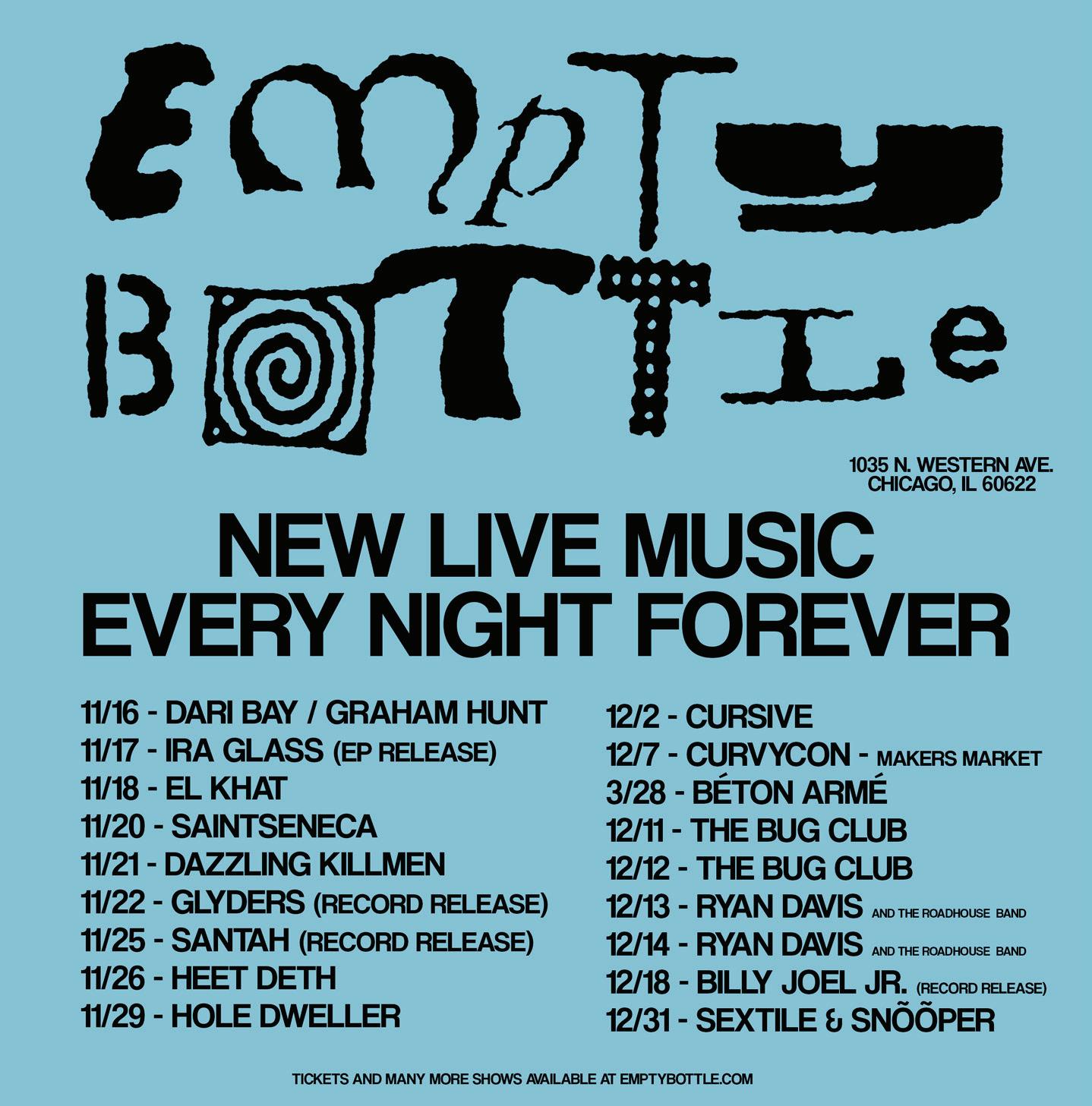
Recommended and notable shows with critics’ insights for the week of November 13
b ALL AGES F
THURSDAY13
PICK OF THE WEEK
Pixel Grip make dangerous dark electro to thrill the pop set on Percepticide

PIXEL GRIP, THE SERFS, JUSTIN AULIS LONG (DJ SET)
Fri 11/14, 9 PM, Metro, 3730 N. Clark, advance tickets sold out. 18+
DESIRE COURSES THROUGH the latest album by Chicago industrialpop trio Pixel Grip. On June’s Percepticide: The Death of Reality, the band’s dark electro taps into the explosive, thrilling immediacy of electroclash, and front woman Rita Lukea sings alternately bawdy and demanding lyrics with a channel-changing mix of seductive poise, domineering force, and unhinged wildness. Pixel Grip also sound like they want to be huge—the sleek crunch of Percepticide could convert Charli XCX stans already accustomed to pop songs with an edge. Percepticide achieves this without the chest-rattling thump of 2021’s Arena, whose irresistible tracks can stir up a sweaty dance floor with their skull-crushing bass, deranged horror-flick synths, and relent-
less assembly-line beats. Percepticide feels less dangerous, but it still thrums with the tense energy of hearing something forbidden and “knowing too much”—the shadowy guitar ri and distorted, propulsive hi-hats of “Moment With God” feel like being pursued through a subway station in a futuristic noir. Pixel Grip may be on the way to crossing over, depending on how you read the tea leaves. Lots of news outlets have focused on Travis Scott’s unauthorized sampling of Arena track “Pursuit” for his July release “Kick Out,” but I’m much more interested in the fact that Pixel Grip got to hang with Trent Reznor during Nine Inch Nails’ United Center shows in August—for a band making this kind of music, I don’t think you could ask for a better cosign. —LEOR GALIL
Facing Accessory and Uniflora open. 9 PM, Empty Bottle, 1035 N. Western, $16.17. 21+
Newish Chicago art-pop group Facing consists of three musicians from the city’s underground scene: Kirk Rawlings (guitar, bass, drums, programming, backing vocals), best known as half of experimental electronic duo Courtesy; Nathan Whitman (bass, guitar, programming), whose credits include a long stint as a touring bassist for the Appleseed Cast; and Claudia Ferme (vocals, guitar), who makes warm, introspective dream pop as Claude. The trio debuted last September with the single “Water,” where Ferme’s airy, sing-song vocals float over a minimal electronic beat, apparently unruffled by blips of echo, bursts of static, and startling interjections of dub percussion. On Facing’s brand-new album, Temporary Bodies, Ferme maintains a similarly detached, chilly vibe, though the band’s sultry, atmospheric alt-pop gets much bigger and more rousing. Opener “Please” starts as hazy, robotic postpunk before piling on a heap of guitar fuzz. The sweltering “Paralyzed” recalls Y2Kera industrial pop with its understated vocals, clubready beats, and moody webs of noise. Temporary Bodies o en wears its influences on its black mesh sleeves, but the band also carve out a path of their own. “Helena” builds intensity over sparse percussion, and around the song’s halfway point Facing flip the script to break into a fuller-bodied arrangement of meandering guitar and motorik grooves.
—JAMIE LUDWIG
FRIDAY14
Pixel Grip See Pick of the Week at le . The Serfs and Justin Aulis Long (DJ set) open. 9 PM, Metro, 3730 N. Clark, advance tickets sold out. 18+
Rwake Racetraitor and Motherless open. 9 PM, Sleeping Village, 3734 W. Belmont, $25.75. 21+
Sometimes the warriors you need aren’t the warriors you expect. In March, Little Rock psychedelic metal outfit Rwake (pronounced “wake”) released a majestic comeback album, The Return of Magik (Relapse), their first full-length since 2011’s Rest. The band formed in 1996, and a er a series of increasingly ambitious releases, its members took off for much of the past 15 years to focus on concerns such as raising families. But they never lost the desire to make music together, and The Return of Magik feels like it’s arrived exactly when and where it needed to, a er years of fermenting and simmering underground. It’s as though a legendary king, asleep beneath a mountain, has been roused by a time of great turbulence and turmoil.
The music feels timeless but also picks up where Rest le off, providing a heavy, doomy psychedelic awakening that takes you on an initiatory spiritual journey. Front man Chris “CT” Terry acts as priest, confessor, cult leader, and shaman—in more mundane terms, he’s the guy on a group mushroom trip who narrates and interprets every hallucination—
YULIA SHUR
while fellow lead singer and keyboardist Brittany Fugate uses cathartic howls to express that which cannot easily be communicated in words. Rwake are in fierce form throughout the album. Guitarist John Judkins (who joined the band in 2011) and new lead guitarist Austin Sublett weave together urgent, electrifying lines, and their high, wiry licks highlight the monster riffs of “With Stardust Flowers.” The thematic through line of The Return of Magik is the upli ing possibility of redemption through trial by fire, but its complex arrangements and raw, battle-tested vocals remind us that this road is never easy or without danger.
Jim “Dandy” Mangrum of southern-rock legends Black Oak Arkansas opens the album’s cinematic, haunting 14-minute centerpiece, “Distant Constellations and the Psychedelic Incarceration,” with a poem cautioning against becoming trapped in a “psychedelic jail” of the mind. Terry and Fugate respond by considering the awesome power of sacrifi ce, painting vivid pictures with lyrics about Christ keeping company with pagan gods and soul-embodied stars on the astral plane. It’s southern gothic folk horror coated in strange and colorful cosmic dust. The following track, “In After Reverse,” features a spooky spoken-word interlude, and its so , proggy melody lures you into a false sense of security before the song swi ly builds in intensity—as though you’re trapped in a burning house that’s about to explode in a prismatic shower of molten metal.
On the title track, when Terry shrieks “It’s the return of magik in the crystal fucking palace,” it’s both terrifying and beautiful. Rwake have always been a powerful live act, and the energy crackling from this heady album should be overwhelming when the band’s full six-piece lineup delivers its deliciously dense complexity onstage.
—MONICA KENDRICK
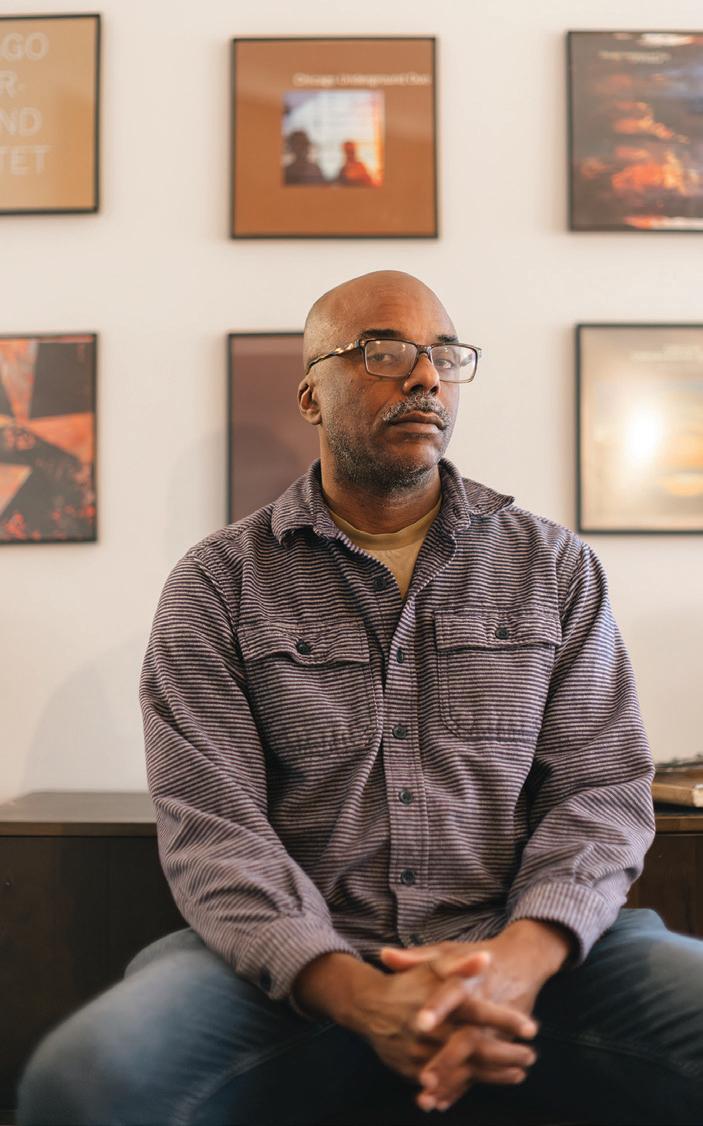
SATURDAY15
Chad Taylor Quintet 8:30 PM, Constellation, 3111 N. Western, $20.72. 18+
It’s tempting to claim Chad Taylor as a Chicagoan. The drummer, percussionist, and educator grew up here, and his longest-running project, the Chicago Underground franchise—which can take the form of the Chicago Underground Duo, Trio, Quartet, or Orchestra, depending on how many people join Taylor and multi-instrumentalist Rob Mazurek— bears the city’s name. He’s also made a diverse and impressive body of work with other current and former Chicago residents, including Joshua Abrams, Fred Anderson, Jaimie Branch, Paul Giallorenzo, Jeff Parker, Matana Roberts, Jason Stein, and Ken Vandermark. But Taylor left town in 2001; he now lives in Philadelphia, and he’s been the director of jazz studies at the University of Pittsburgh since 2024. Over the past couple decades, he’s sustained rich associations with prominent jazz artists outside Chicago too, including Marc Ribot, Eric Revis, Craig Taborn, and James Brandon Lewis, and he’s led a series of bands under his own name. In every setting, Taylor’s propulsive grooves, deft decorations, and knack for shoring up a piece’s underlying forms enrich the music. His brand-new album, Smoke Shifter (Otherly Love), introduces a mostly Philadelphia-based quintet whose output steers closer to mainstream jazz than many of his previous collaborations.
The album’s compositions, which include contributions from Taylor, vibraphonist Victor VieiraBranco, and tenor saxophonist Bryan Rogers, feature intricately constructed themes that showcase the rich melodic language of Rogers and trumpeter Jonathan Finlayson (the ensemble’s sole nonPhiladelphian). Bassist Matt Engle provides a sturdy pulse that gives Taylor plenty of room to explore his knack for elegant elaboration. This show at Constellation is the quintet’s first Chicago appearance.
—BILL MEYER
SUNDAY16
Danny Brown Underscores and Femtanyl open. 7:30 PM, the Vic, 3145 N. Sheffield, $47.88–$53.60. 18+
In Pitchfork’s My Perfect 10 series, a critically adored musician (who’s usually promoting a new album) praises a favorite record. For an October entry, rambunctious Detroit rapper Danny Brown chose Wallsocket , a 2023 album by digicore upstart Underscores, aka April Harper Grey. “A er getting sober and coming out of rehab, I discovered this album,” Brown said, “and it just made me fall back in love with music again.” When it comes to his adoration for Underscores, Brown is walking the talk: He collaborated with her on two tracks on his new album, Stardust (Warp), including the deconstructed house single “Copycats.” Brown is comfortably middle-aged (he turned 44 this year), but he’s not settling into the familiar. The style hopping on Stardust isn’t just restless—it’s downright delirious. He made the album in collaboration with several younger musicians,


most of whom emerged from hyperpop and digicore (among them NYC-based duo Frost Children and Chicago wiz Jane Remover) and all of whom twist pop into unexpected shapes. These collaborations, which also include a tune with Chicagoan and Sooper Records cofounder Nnamdï, have produced intense, erratic instrumentals whose wild lunges and strange midsong shi s leave little room for any vocalist to make an impression. But

Brown is hardly any vocalist. His adenoidal rapping is more than a match for the album’s digital din, and his quicksilver performances cut through the labyrinthine arrangements like Mario leaping through rotating spires of fi re. Stardust isn’t just a big stylistic swing from a veteran rapper—it also shows us what can happen when Brown finds a new source of energy and decides to see where it leads him.
—LEOR GALIL v
Chad Taylor DAVID MCDOWELL
Rwake BRENDAN DONOHUE
Facing KEVIN ALLEN
Danny Brown ARIEL FISHER
GOSSIP WOLF
TORN LIGHT RECORDS moved from Cincinnati to Chicago’s Bucktown neighborhood in June 2024 and quickly established itself as one of our city’s premier record stores. But in early October, broken plumbing in the unit above Torn Light flooded the shop four times in a 48-hour period, forcing owners Alex York and Dan Buckley to temporarily shutter the storefront. “It was a very scary month,” York says. “Truly horrible, making zero dollars for a month. For a small business, it doesn’t work. We don’t have excess cash.” Earlier in November, York and Buckley got some money from their insurance company, and they’ve been diligently working to reopen the shop. York hopes it will be back in business this weekend.
York estimates that Torn Light has lost nearly 5,000 records to water damage, and 3,000 of those make up the shop’s entire online inventory of seven- inches. “The sections that were hit were jazz, modern classical, avant-garde,” he says. “So kind of our hallmarks for larger sales and things that people traveling will stop in to buy from us.” Over the past month, York and Buckley have depleted their modest savings to pay staff while waiting on their insurance claim. York says insurance is helping cover the cost of replacing the furniture that Buckley built for Torn Light, but even with that payout, restocking is a challenge for a shop that mostly sells used records, CDs, and cassettes.
A furry ear to the ground of the local music scene
en 17 , which is throwing in the towel. “We decided to close for the same reason many businesses close: Unfortunately, the bottom line just wasn’t there,” says co-owner Joe Mertz. Mertz and co-owner Jennie Plasterer opened the Fallen Log in March 2023, shortly after moving Kitchen 17 to Avondale from Lakeview, and it quickly became one of the most interesting venues in Chicago. It hosted
comes in and continues the venue, especially the all-ages portion,”

Mertz says. “It’s hard to do, but I have really come to believe that it is important for the community, and I hope that some of that legacy lives on.”
The Fallen Log will host a closing party and farewell show on Tuesday, November 25, but the details hadn’t been announced by publication time.


“A lot of the inventory we have, it’s not necessarily replaceable,” York says. “Of course, I could find a Cecil Taylor LP again, but if I have it out for $20, I probably found it for $12 somewhere— how the hell am I gonna find that again? We’re just having to do whatever we can.” Torn Light’s staff have come to terms with the necessity to reopen the shop with a slimmer selection. “Reopening without our jazz section is crazy to me,” York says, “but I’m just trying to let go of it and say, ‘This is just a small blip in time in a much larger lineage of the store. We will have jazz records again.’”
LAST WEEK, WORD spread through Chicago’s DIY scene that Avondale venue the Fallen Log was closing. On Friday, the business made it official with a public announcement: Its last day would be Sunday, November 23. The Fallen Log has shared ownership and a building with vegan pizza spot Kitch-
a range of underground bands that ordinarily play DIY spaces, and most of its shows were all-ages—a rarity among aboveground venues.
Cole Hunt of TV Buddha served as the Fallen Log’s talent buyer for about a year and a half, and he o en brought in emerging acts from the Hallogallo indie-rock scene. Even after he moved on, the scene maintained a connection to the Fallen Log. In August, for example, Peter Cimbalo (live drummer for Kai Slater’s Sharp Pins project) celebrated his new psych-tinged album as Alga with a full-band set at Fallen Log. “I hope someone
LAST WEEK, PUBLIC Works launched preorders for a T-shirt called “Fuck ICE: A Popular American Sentiment.” Public Works is a Wicker Park gallery, shop, and venue connected to design studio and music label Someoddpilot, and its new shirt is printed with a photo of a miked-up amplifier cabinet with “Fuck ICE” spelled out in tape across its grille. The shirts cost $40, and proceeds (about $25 per shirt) will go to immigrantfocused liberatory community organization Palenque LSNA and other efforts to support those harmed by ICE. The first run of shirts begins shipping Saturday, November 15.
ON FRIDAY, NOVEMBER 14 , uncompromising Chicago posthardcore band Ira Glass will drop the EP Joy Is No Knocking Nation, their second for Fire Talk imprint Angel Tapes . This time the group’s intense din makes more use of Jill Roth ’s saxophone blasts, which o en underscore the dread in Lise Ivanova ’s half-spoken, half-screamed vocals. Ira Glass celebrate their new EP by headlining a free Empty Bottle show on Monday, November 17. Repent and Alive Girl open; Henry Tegethoff spins between sets. Music starts at 9 PM.
CELLIST AND SOUND ARTIST Lia Kohl releases her latest solo album, Various Small Whistles and a Song , on Friday, November 14. She performs at Constellation that night alongside Chicago postrock trio Alta Vista, who are also celebrating a new record: Won’t Believe in Dust builds on the searching, warped Americana of their 2023 selftitled debut. Tickets cost $20.72, and the show begins at 8:30 PM. —LEOR GALIL Got a tip? Email your Chicago music news to

JOBS
Legal Practice Assistant sought by Musillami & Connealy LLC in Chicago, IL for admin support, legal compliance & documentation, bus. dvlpmnt & client relations, research & analysis, doc mngmnt, & workflow optimization. Reqs: BA in Econ, Bus Admin, or rltd field & 1 yr exp in office/ admin role. Must possess course work, intern, or work exp w/ Word Processing, Template Dsgn, & Integration w/ Doc Automation S/ware using MS Word; Email & Calendar Mngmnt in Outlook; & etc. Salary: $55,786/yr. Email Resume: A. Musillami at amm@ mandclegal.com; Ref 101.
Morningstar, Inc. seeks a Senior Analyst (multiple positions) in Chicago, IL to conduct quantitative & qualitative analysis & develop forward-looking ratings on index-based investment strategies (25%). BS deg in Finance, Econ, Accounting, or a rltd field or foreign equiv & 3 yrs of relevant exp req’d. Add’l specific skills req’d. Base salary: $57,013-$105,800 per year. For position details & to apply, visit: https://www. morningstar.com/careers ; ref. job ID REQ-052782.
Morningstar, Inc. seeks Senior Software Engineer (multiple positions) in Chicago, IL to tackle complex development tasks. Utilize extensive expertise to design & implement intricate solutions that meet product reqs & quality needs w/ respect to
functionality, performance, scalability, reliability, schedules & adherence to wealth group goals & principles (20%). BS deg in Comp Sci, Comp Engg or rltd field, or foreign equiv & 5 yrs of relevant programming exp req’d. Will accept any suitable combination of education, training, and experience. Add’l specific skills req’d. Base salary: $148,949/ year. For position details & to apply, visit: https://www. morningstar.com/careers; ref. job ID REQ-052976
Morningstar, Inc. seeks Workday Reporting & Analytics Product Owner (multiple positions) in Chicago, IL to serve as primary subject matter expert for Workday to optimize system design, understanding & interpreting end user needs to translate into system requirements, creating & managing documentation used for end user adoption & training. BS in Comp Sci, Math, or rltd field, or foreign equiv & 5 yrs of rltd reporting & analytics exp req’d. In alternative, MS in Comp Sci, Math, or rltd field, or foreign equiv & 3 yrs of rltd reporting & analytics exp. Add’l specific skills req’d. Base salary: $138,715-$150,000/year. For position details & to apply, visit: https://www. morningstar.com/careers; ref. job ID REQ-052783.
YL Law Firm LLC has mult. [HEX:202f]openings avail.: Master’s only/Foreign equiv. acptd.:[HEX:202f]
Accountant (YFLA25): Examine, anlyze. & intrpt. Acc. records to prep. financial stmts. Mail resume with job ID to HR: 110 N. Wacker Dr., Ste. 2500, Chicago, IL 60606.
ZS Dev Corp seeks Accountant (Chicago, IL) to manage accounts receivable & payable. Must have a bach. deg. in Finance, Accounting,
Business Administration, or equiv. & 5 yrs. of progressive post-bach. exper. in public &/or corporate accounting. Alternatively, must have a master’s deg. in Finance, Accounting, Business Administration, or equiv. & 3 yrs. Of exper. In public &/ or corporate accounting. Must have a Certified Public Accountant (CPA) certification. Salary: $108,000 - 110,000/yr. Benefits include medical & dental insurance, PTO, & 401k. To apply send CV to kkiefer@zsdcorp.com.

SERVICES
CHESTNUT
ORGANIZING AND CLEANING SERVICES: especially for people who need an organizing service because of depression, elderly, physical or mental challenges or other causes for your home’s clutter, disorganization, dysfunction, etc. We can organize for the downsizing of your current possessions to more easily move into a smaller home. With your help, we can help to organize your move. We can organize and clean for the deceased in lieu of having the bereaved needing to do the preparation to sell or rent the deceased’s home. We are absolutely not judgmental; we’ve seen and done “worse” than your job assignment. With your help, can we please help you? Chestnut Cleaning Service: 312-332-5575. www.ChestnutCleaning. com www. ChestnutCleaning.com



